#encyclopedia of women in the renaissance
Text
Louise Bourgeois (Louise Boursier), 1563-1636
Midwife to Queen Marie de Médicis, renowned author of medical textbooks translated into many languages

Born in Paris, Louise Bourgeois in 1584 married the king’s surgeon Martin Boursier, with whom she had five children. She led a very happy life. But during the Religious Wars, the Boursier family was forced to leave Paris and find refuge in Tours, where they suffered a life of financial difficulties. Returning to Paris, Louise Boursier became a midwife to provide financial assistance to her family. In spite of opposition from within the profession, she practiced for five years among the poor and became a registered midwife in 1598. This period of her life is recounted at the beginning of her Recit veritable de la naissance de messeigneurs etdames les enfans de France (True Account of the Birth of the Sons and Daughters of France).
In 1601, a wonderful opportunity was offered to Louise Boursier: Queen Marie de Médicis was looking for a midwife. Demonstrating a strong sense of authority and loyalty, Louise Boursier was chosen by the queen to deliver her six children between 1601 and 1610 (the year King Henry IV was assassinated). Louise Boursier was well respected and became the most popular midwife at the court.In 1627, however, Marie de Bourbon Montpensier gave birth to her daughter, Anne-Marie-Louise d’Orléans (La Grande Mademoiselle),and died suddenly of a puerperal fever. Her midwife, Louise Boursier, was accused of negligence by the physicians who did the autopsy. Her popularity began to decline, and she spent the rest of her life writing and publishing very successful books about her art until her death in 1636. Her famous works were read all over Europe. First published in 1609, her Observations diverses, sur la stérilité, perte de fruict, foecondité, accouchements, et maladies des femmes, et enfants nouveaux naiz (Various Observations on Sterility, Miscarriage, Ability to Conceive, Childbirth, Female Illnesses,and Infants) provides scientific remarks on obstetrics and numerous guidelines for the care of the pregnant woman as well as her infant. Becoming the manual of reference, this book was augmented and published again and again (in 1617, 1626, 1634, 1642, and 1652). It was also translated into Latin, German, Dutch, and English, underscoring the importance of her European reputation at that time. Some parts of her works are of particular interest: Recueil des Secrets, de Louyse Bourgeois dite Boursier (Book of Secrets of Louise Bourgeois Boursier), published just before she died (1635), is a compilation of recipes for women for the treatment of ailments such as skin eruptions, painful periods, and the like.The most interesting writings of Louise Boursier are the Récit véritable (True Account) and the Instruction à ma fille (Advice to my Daughter), both published in 1617, where she presents her short autobiography as well as the spiritual testament of an exemplary midwife.
In her own time, the well-educated and highly competent Louise Boursier was something of an anomaly, first among her male coworkers, who came to resent her as she became a self-confident practitioner, and also among other sworn midwives who saw her as a formidable challenger to their own preeminence in the field because of her marriage to a surgeon and her unusual training (Louise had studied Ambroise Paré’s book on obstetrics). Furthermore, important changes were taking place in the medical and surgical professions. For centuries, women, having gained their skills from experience, monopolized midwifery. With the upsurge of medical science in the sixteenth century, physicians became more interested in the art of delivery, and, as organized instruction and licensing became prevalent, these requirements extended also to women engaged in midwifery.
In a time of growing suspicion over women’s capacities to handle child delivery, Louise Boursier understood the need for formal training and collaboration with male physicians and surgeons. She saw herself as the founder of a new generation of midwives, more knowledgeable and better trained. In her effort to educate those who would follow her, she published Instruction à ma fille, the first treatise in French on the art of midwifery. She recorded her theories on maternity care and her experiences in Parisian society in her Récit veritable. This important work provides a unique source of information about midwifery practices in the early modern period as well as insights into the challenges women faced as they entered the professional world.
Colette H. Winn, in Encyclopedia of Women in the Renaissance
#xvi#xvii#louise bourgeois#louise boursier#midwifery#marie de médicis#ambroise paré#marie de bourbon-montpensier#anne-marie-louise d'orléans#la grande mademoiselle#encyclopedia of women in the renaissance#colette h. winn
10 notes
·
View notes
Text
The flat stomach was not always an aspect of the ideal female form. Idealized women’s bodies in artistic representations tended to be symmetrical. However, rounded or fleshy (rather than flat or muscular) abdomens were the norm in ancient and Renaissance art
i was reading cultural encyclopedia of the body and it said this but idk if its like...true? like. here are some results for ancient greek statues of naked women
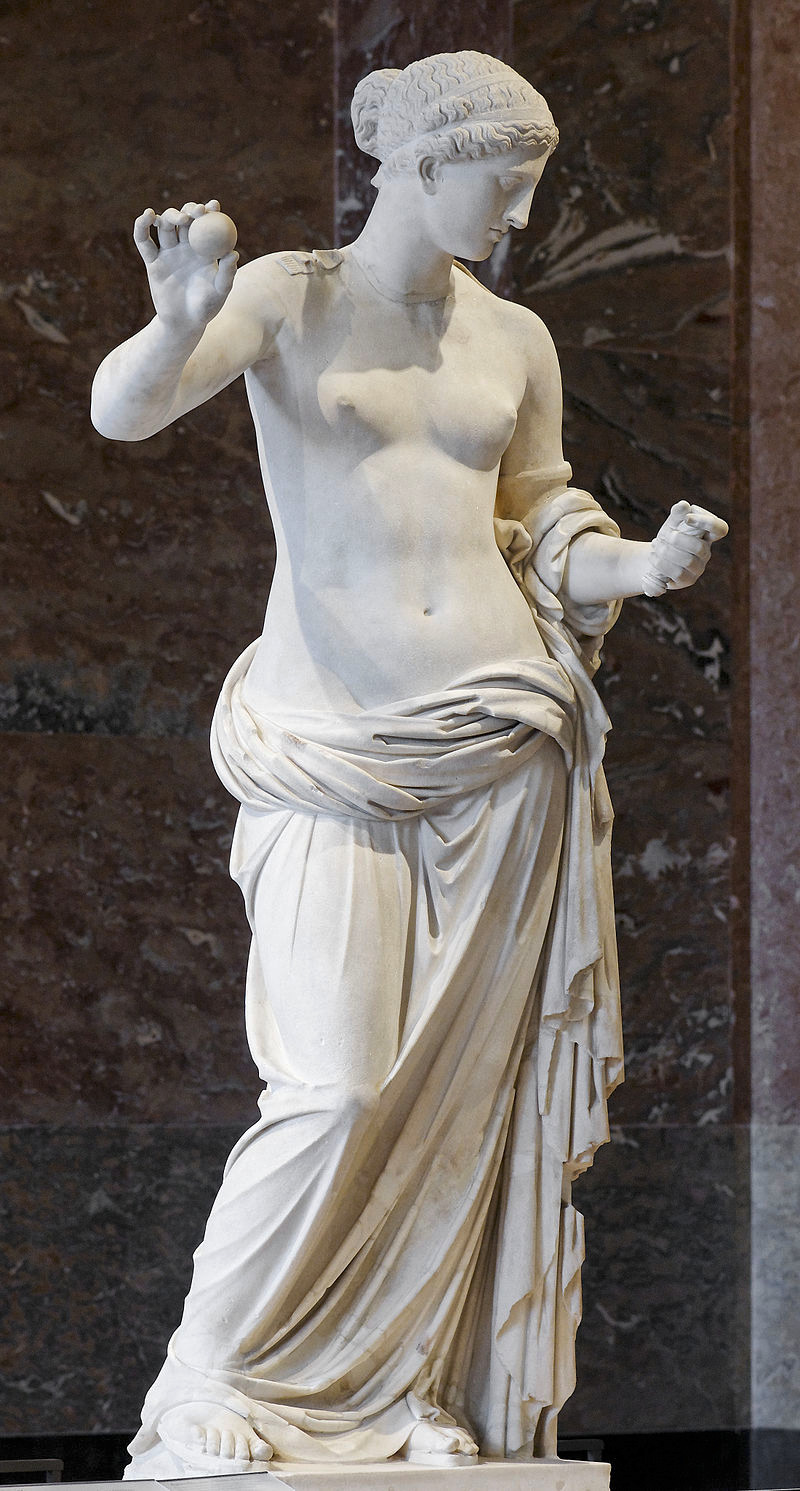
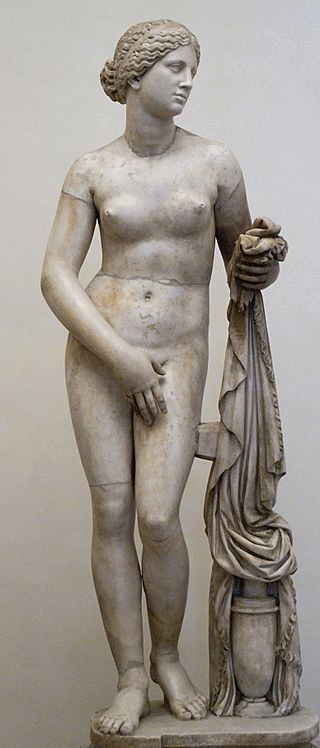
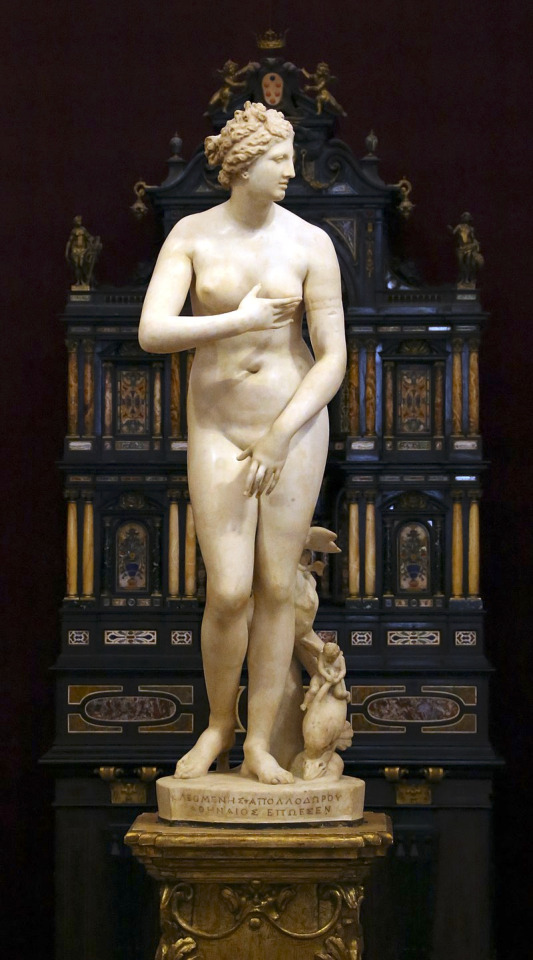
note their stomachs! pretty flat!
and its not just venus (as above). bam, ishtar!
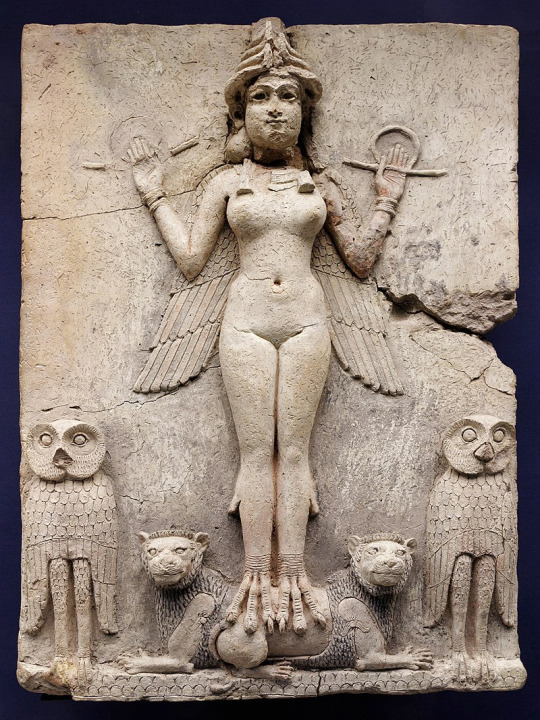
this article mentions crouching venus, who doesnt totally have a flat stomach?
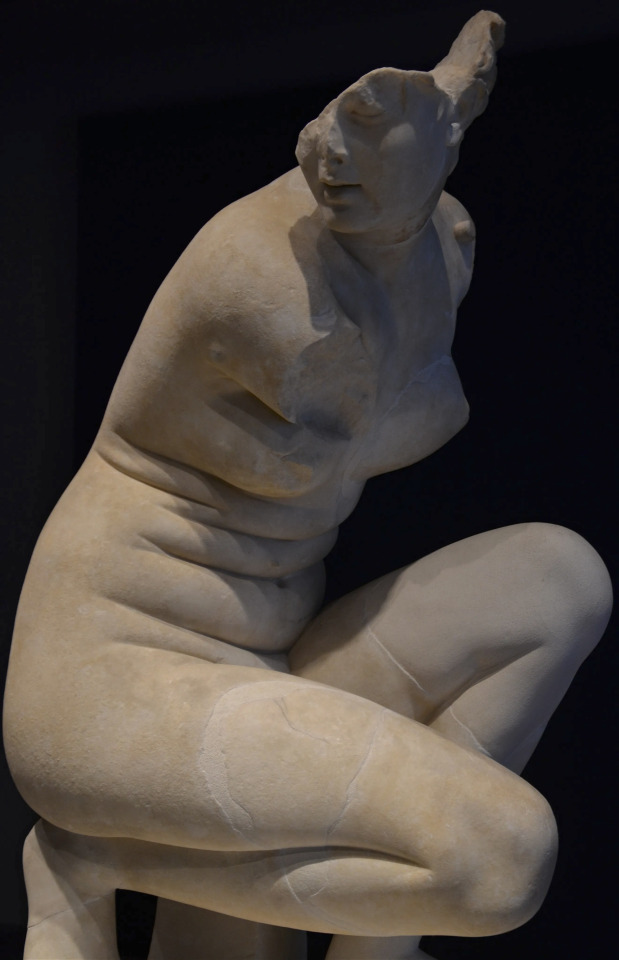
but like. literally everyones stomach looks like that when they crouch. and bend over. i think this is still unambiguously someone with a flat stomach!
i mean there definitely were neolithic statues without flat stomachs. but they seems strangely uncommon after that!
30 notes
·
View notes
Text
In the middle of one of the rooms of the Josephinum, laid out in a glass coffin like Snow White, is the figure of a beautiful nude woman. She lies on her back, in a pose suggesting intoxication or orgasm more than sleep: one knee slightly bent, hands rucking the silk sheets beneat her, her had tilted back in abandon or ecstasy. She has been slashed open from throat to groin. Her breasts hang to the sides, just flaps of wax, and her guts are a bulbous dark mass against her alabaster skin, coils of intestine resting on a pristine hip. On top of her long blonde hair, which spills prettily around her shoulders, is a delicate circlet of gold.
Next to her, in a similar glass and rosewood box, lies another lounging blonde figure, this one wearing a string of pearls. Her torso, too, is open, but not in the manner of a crime or an autopsy. The front of her torso has simply been sliced off in a neat, bloodless curve and deposited elsewhere. Instead of breasts, she has smooth expanses of light brown lung underneath her pearls. Under that, her diaphragm folds like a wing over her stomach and a neat tongue of pancreas. Something, maybe a kidney, lies by her side. Her eyes are open, and her expression is not exactly orgasmic; it is, more than anything, resigned. Tucked inside her pelvis is a fetus the size of a fist.
These are "anatomical Venuses", an eighteenth-century innovation in medical display: lovingly detailed wax models of ideal feminine beauties with real eyelashes and human hair and jewelry and abdomens full of gore. The Josephinum Venuses, and a number of other surviving Venuses of Europe, come out of the wax workshop of a Florentine museum: the Museum for Physics and Natural History, also known as La Specola. La Specola, like the Josephinum, is full of models depicting aspects of human anatomy -- "an encyclopedia of the human body in wax," as Joanna Ebenstein puts it in her lavishly photographed book The Anatomical Venus. Unlike dissection, wax was sanitary, odorless, and stable over a long period of time. It was also, potentially, beautiful. Wax models could be rendered placid and pain-free, their otherwise lovely faces and bodies drawing the mind away from death and towards higher (and lower) things. Like the Renaissance anatomical illustrations that preceded them, the La Specola waxworks were intended to show the hand of God in the human design. The luminous wax sculptures even called to mind earlier religious figurines. But they were also meant to be visually, even sexually, appealing. (This is why, despite the preponderence of male anatomical illustrations and models and cadaver dissections, there was no male equivalent of the Venus.) Ebenstein quotes eighteenth-century anatomical illustrator Arnaud-Éloi Gautier d'Agoty: "For men to be instructed, they must be seduced by aesthetics, but how can anyone render the image of death agreeable?" The anatomical Venus was the answer: the instructional realism of human innards, leavened by the seductive aesthetics of feminine beauty.
Zimmerman, Jess. Women and Other Monsters: Building a New Mythology. Beacon Press, 2021.
#jess zimmerman#women and other monsters#women and other monsters: building a new mythology#anatomical venus#excerpts#prose#nonfiction#*
3 notes
·
View notes
Text
Married Single Mothers
A married single mother is a married woman with kids, usually in a dual-income household, who receives no help from her husband with cooking, cleaning, or childcare, such that the way she spends her time - take kids to daycare, go to work, pick kids up, make dinner, put kids to bed, clean (maybe), go to bed - looks like it would if she were a single mother.
Back In The Day(TM) when a dual-income household looked more like a man working a strenuous or high-stress job for long hours, while his wife worked part time, or perhaps full-time in something that was low stress or didn't pay a lot, maybe it could be justified that he could come home, crack open A Beer, sit in the Recliner, and watch The Big Game with no asks or responsibilities. After all, they had a big yard for him to cut, a picket fence to keep painted, two cars to keep up, and a "Honey Do" list.
To avoid rehashing the history of work hours them over time, and the factor of profession choice, here are two sources if you don't already know what I'm talking about:
https://eh.net/encyclopedia/hours-of-work-in-u-s-history/
https://www.bls.gov/opub/mlr/1997/04/art1full.pdf
Now, however, the gap between men and women's hours worked and the type of work they're doing is closing. If there's a couple who are bringing home similar wages at a non-management desk job, and maybe she works 40 hours and he works 44 hours. It's really hard to argue why that 4 extra hours of work justifies him watching TV, hanging out with friends, or doing his hobbies instead of helping with childcare or other "indoor chores". If they're urban renters, he can't even claim that more strenuous but less frequent chores like home repairs, cutting the grass or fixing the cars compensate for not cooking, cleaning, or raising his kids. Oh you take the trash to the dumpster? So does the 60 year old lady down the hall?
As I usually do, I'll start by blaming the Victorians by democratizing upper-class gender roles because, now displaced from their farms and having their work taken away by machines and mass production, middle class women had nothing to do. Now, working was just for the poor, and middle-class Victorian identity revolved a great deal around not looking poor. What were they supposed to do all day? Definitely not become rigorously educated or political active...At the same time, child labor was outlawed (considering factories and mines are different from family farms, justifiably so) and children became "economically worthless but emotionally priceless". So, like eugenics and breeding fucked-up-looking dogs, a contrived version of floral saccharine motherhood became the status quo -- be dedicate the whole of one's being, identity, purpose, and existence to raising children.
The 1950s were almost like a Renaissance of this ideal, likely as a reflexive response to men being away in the hell that is war. Women who may not have chosen to do so under any other circumstances were working in factories, filling in other jobs men left for the war, and having to live in relative austerity due to wartime rationing and shortages. A lot of men returning from the war were lonely and homeless, and they'd spent their time away living in inhospitable concrete bunkers and mud holes, constantly surrounded by death and destruction, and not knowing if they will go home at all (would home even be there when they returned?). Women whose husbands or boyfriends were drafted spent all that time wondering if that man could be dead. Single women had to mostly put their romantic lives on hold. When the war ended, most people was overcompensating toward cocooning and romanticization of home, social order, and family life.
Do I blame them? Not necessarily.
Has it still had unintended negative consequences? Yeah.
Trad LARPers idealize the 1950s when it was actually a very exceptional time. On one hand, it was the result of a psychological reaction against WWII. On the other, it was a time of unprecedented economic prosperity -- and what goes up must come down. I'm not an economist but I do subscribe to the cyclical view of history and even if the general trend line of something like GDP trends upward, it has to go down to some extent to move upward.
https://ourworldindata.org/female-labor-supply
Women's labor participation in the US and UK had marginally increased from pre-WWII to post-war. Interestingly, Germany had about 15-20% higher female labor participation than the US since about 1895, which also increased gradually during the pre-WWII era, and peaked during Kinder, Küche, Kirche Nazi rule before returning to a similar level as 1895, where it remained until the 1980s. It's not as simple as every Western woman was once fulfilled as a docile tradwife, then Betty Friedan wrote a book, and then the fabric of society was torn asunder by the Boss Babe Apocalypse.
If not feminism, then what do I think made it so hard for families to live on a single income - gender of the earner irrelevant - and made things so generally unaffordable?
Three words: The Powell Memo.
youtube
I would caution against taking the memo at face value as many do, as an earnest call for business leaders to defend themselves against Communists and Fascists who hate "free enterprise". Rather, it can be read as an emotional fear-mongering call for businesses to weaponize the government to, really, take over the country in a multi-pronged effort which resulted in neoconservative and arguably neoliberalism.
At timestamp 48:17 Historiansplaining starts analyzing the memo and placing it in the larger context. Please listen to it. It's comfortable to listen to at 2x speed so it's not that long. There are shorter views but they are extremely biased and not near as nuanced as this one.
The banking industry is a problem. Obviously having the most people with the most debt possible that they're still able to reliably pay on is in the interest of banks. If it exists, there's a loan for it. Credit card debt is a huge problem for Americans. The 30 year mortgage was introduced with the New Deal to help destitute people buy houses, now most people who buy houses use a 30 year mortgage to have remotely affordable payments. There are now 50 year mortgages and those will be the "new normal" if the trend doesn't reverse.
Part of the housing cost crisis is due to 1920s-1060s zoning restrictions created to protect property values, but also to create de facto class- and race-segregated neighborhoods. I'm not the type of person to argue that it's a human right to live in downtown LA or Manhattan, but if it's possible and desired to build affordable housing in a certain place and the only thing preventing it is zoning law, lobbyists, or NIMBY Karens, then that's a problem that can and should be addressed.
The auto industry and adjacent corporations lobbied urban planners to design in a way that would encourage or force people to buy their products. We have the automakers weighing in on efficiency standards such that, instead of like every other country that bases efficiency on weight, American cars are based on footprint which gives automakers leeway to sell more profitable SUVs. Do we need screens and cameras in our cars? No, but people who want new cars don't have another option. Can't afford it? Some companies (ex. Nissan) have moved from 7- to 10-year car loans. By the time you've paid your car off, the transmission will have turned into a tube of K'Nex and it'll be time to finance another one.
College loans, whether they're through a bank or the government -- universities win because they got your money. The Boomers were the last generation to be able to pay for their tuition with a summer job flipping burgers. The midcentury expansion of federal lending - which like the 30 year mortgage started as a measure strictly for the very poor - has caused tuition to fill the space allotted. Useless majors and required electives have exploded since the federal student loan expansion.

Speaking of which, credential inflation means that not only do you have to pay more for college, but you have to go longer just to access the same jobs. In some fields, someone with a Masters degree and the debt to go with it may end up earning just a bit more than the hypothetical $15/hour minimum wage.
The majority of Americans live in a state of debt slavery as a result of what some may call "crony capitalism" but I prefer "economic Fascism" because a) The F-Word makes a lot of people uncomfortable and b) it's technically true. Corporatism, the economic facet of Fascism is defined as "the organization of society by corporate groups, such as agricultural, labour, military, business, scientific, or guild associations, on the basis of their common interest".
If we don't live in economic Fascism, then what the fuck would we be doing different?
After addressing the contrivance that is gender roles-as-we-know-them and going on a meander through economics, I'll now acknowledge my digression and return to the topic of married single mothers.
Due to these economic conditions, most households with kids are dual income by necessity. Tradcons like to portray dual-income households as self-indulgently depriving their kids of an at-home parent for the sake of affording a bigger house, nicer cars, or more vacations. That's not the case and most dual-income households are that way moreso to afford necessities, and I don't think it's reasonable to expect a whole family to move into one of their parents' house, get on benefits, or live in a van just to be able to be able to afford being single-income.
In general, the root of the problem, unsurprisingly, is the mismatch between neo-midcentury ways of doing things and the reality of The Current Year.
The neo-midcentury way goes somewhat like: go to college for your Passion. Get an advanced degree because - don't worry - you will be able to get a high paying job and the debt won't be a problem if the name on your diploma is a Very Good one. Just go to college. Just get a degree.
Like the mainstream media tells you, look for Love At First Sight. Don't be a buzz-kill who thinks or talks about your future plans until at least 6 months into the relationship when you're afraid to leave due to sunk-cost fallacy and secretly afraid to commit due to FOMO. Time to get married. This is such a special time to have your first debt together. Make sure you have a credit card to put your honeymoon on.
Move to a high-demand area, but not so high-demand that you can't afford it obviously. You're going to want to move to the second most popular area so your commute can be between 1-2 hours and your mortgage will assure you live paycheck to paycheck. Because you're commuting for so much of the day, you'll need a nice car, so definitely buy it new.
Now it's time to have a kid. Everything you've done to this point, you find, has set you up in one way or another for failure. It would be cheaper for one to stay home, but their future earnings would be at risk and it's too expensive to pay for two student loans with one paycheck. Plus his spreadsheet job is just so much more important than your spreadsheet job. Because why? Because it just is. You've already moved a few hour drive away from any relatives who could help with childcare.
"Did we really agree to have kids? Did we really want it to be like this? Or were we just going through the motions, smiling and nodding to the expectations of society and our parents?" you wonder as the 18 month old in your arms noticeably shits their diaper and hits you in the face with a sippy cup while you stoop to pick up the dino nugget the 3 year old has dropped over and over again while some Cocomelon bullshit plays on their greasy, sticky iPad...all while your husband plays Elden Ring in the next room. You call out for help. Did he really not hear you, or does he want plausible deniability. Who is this man you married?
But wait...your vision is black with a glowing orange circle above. You hear distant music. You open your eyes...
"Destination wedding? Cocomelon? Married single mom? What are you talking about? You must have hit your head hard," says a teenager with greasy black hair and a Korn t-shirt.
They extend their hand and help you off the ground. You stand.
"Come on, we're gonna miss Hatebreed."
I'm not an antinatalist, so I lean toward most people probably should at least consider having kids. I, for one, want the human species to persist. People who don't are pretty cringe -- black-pilled about the environment, or they're mad that they were born without their consent (?) because they have to wake up every day and experience First World Problems.
Who we decide to marry is possibly the most important decision we make. More than where we live or what profession we choose. We're caught between the old-fashioned way that works under a specific set of circumstances that largely don't apply anymore, and a modern way that is little more than a reactionary movement against the social mores of Old People without considering life beyond age 27.
As Nietzsche foretold (PBUH), modernity puts us in a position with no easy answers. We don't have a god telling us what our values are and what we should do with ourselves, and existing with so many possibilities is almost more dangerous and burdensome in a way than having a pre-determined system like tradition. The boundary between good and evil isn't always clear and it's rarely straight. Many enemies take many forms; they can appear as anything and can speak from both sides of their mouth at the same time.
Freedom is very hard because you're not just yourself. You are yourself and god at the same time. It's not as simple as obeying a disembodied voice anymore. I'm not blaming married single moms at all for the position they find themselves in because they're victims of society. People who were supposed to be giving them good advice were giving conflicted and outdated advice, and probably acting out the old axiom that misery loves company.
I really have a beef with the Boomers, too, for normalizing the idea that being married is hell -- the end of one's individuality and anything they once enjoyed or valued. When society holds up doing the bare minimum - it's miserable but it's not outright abusive - as what young people should expect from marriage, it means the young people aren't looking for or insisting on better for themselves.
Women get accused of having unrealistic standards. "They all want a man who's 6' tall, has 6-pack abs, and makes 6 figures!" Fair enough, that's statistically a rare type and not enough to go around to all the women who want that. However, any time a woman has any standards beyond the absolute bare minimum - not physically abusive, not addicted to substances in a functionally detrimental way, has a job, has all his appendages, can walk and talk - it gets compared to asking for a "666 man".
When women complain (rightly) about being a married single mom or the "double shift", particularly tradcon and redpill men will say, "ACKSHYUALLY you don't want a man to help with chores because such and such statistic says women will go bang Alpha Tyrone if their man does chores, so you don't know what you want and you'll actually be happier if you do all chores and childcare yourself because that's what makes women fulfilled."
That's a convenient conclusion to reach.
"There are three kinds of lies: lies, damned lies, and statistics."
-- Mark Twain
People can't want different things, too. Women aren't a monolith. I definitely believe too there are women who don't know what they want. A lot of people in general are running on societal programming that, on some level they recognize is herding them off a cliff, but they don't have the vocabulary - they don't even have the gastalt(?) - to describe what is happening.
There's a very good faith contingent of the men's rights movement that's expressing very admirable sentiments that are compatible with what the good faith contingent of what feminists are saying.
They're saying: "Why are we assumed to be expendable? Why is it shameful for a man to say he wants to stay home and raise a family? Why is a man's worth still based on how much money he makes? Why do some people assume that if a man is interacting with a kid in public that he's a predator? Why are chores and childcare seen as emasculating?"
Some people can believe in and live according to traditional gender roles, which is their business, but there's a missed opportunity here. Many women find conflict between wanting a family and pursuing their career, and/or want a more equitable distribution of housework in dual-income households; and there is a portion of men who would like to be able to care less about their career and more about their family, or they want to raise a family and don't care about work at all.
To the extent that men - or a particular man - are held to a traditional gender role, any woman who involves herself will be expected to fill the complementary support role. In a society where dual-income households are economically mandatory, women can't fulfill that role whether the individual woman wants to or not. Even if she would otherwise enjoy childcare and chores as a SAHM if the choice were available, adding full-time work to that- no one has the mental bandwidth for that.
While the interim quasi-solution for this requires, on an individual level, women to be pragmatic and creative, to look beyond the inadequate guidance of people who grew up in completely different conditions - who arguably didn't even do that fucking great for themselves - "just make better choices" doesn't fix the problem.
The push for women to enter the workforce wasn't accompanied by an equal push for men to enter the home, and I'm going to dedicate a post to that.
#feminism#amazon feminism#married single mothers#performative femininity#stay at home parent#modernity#corporatism#debt slavery#stay at home dad#men's liberation#the second shift#traditional gender roles#gender roles
1 note
·
View note
Text
Unraveling the Tapestry of Gender
Unraveling the Tapestry of Gender
In the vast tapestry of human existence, the threads of gender weave a complex narrative that has evolved over centuries. The exploration of gender is not merely an academic exercise; it is a journey into the heart of societal norms, power dynamics, and human identity. This write-up embarks on a voyage through time, unraveling the historical and contemporary context of gender, delving into its impact on society.
To understand the present, we must first dive into the past. The historical roots of gender roles can be traced back to ancient civilizations, where societal norms often dictated rigid expectations for individuals based on their assigned gender. From the agricultural societies of Mesopotamia to the majestic courts of imperial China (National geographic, n.d.), gender roles were deeply ingrained, shaping the trajectory of human civilization.
In medieval Europe, the constraints on gender reached new heights with the rise of chivalry and feudalism. Women were often relegated to the domestic sphere (Bilancetti, n.d.), while men assumed roles of authority and prowess. The Renaissance period saw a subtle shift, with glimpses of female empowerment emerging in art and literature. However, it was not until the waves of social and political revolutions in the 19th and 20th centuries that significant cracks began to form in the traditional gender edifice.
One of the most pivotal moments in the journey of gender equality was the suffragette movement. Women, tired of being relegated to the shadows of civic life, demanded the right to vote. The battle for suffrage was not just a political struggle but a seismic shift in societal perceptions of women's capabilities. The suffragettes challenged the notion that political participation was the exclusive domain of men, setting the stage for future struggles for gender equality (Encyclopedia Britannica, 2018).
The 20th Century and Beyond: The mid-20th century witnessed the emergence of second-wave feminism, advocating for issues beyond suffrage, such as reproductive rights and workplace equality. The feminist movement sparked conversations about the fluidity and spectrum of gender identities, challenging the binary construct that had confined society for centuries. As we step into the 21st century, the gender discourse has expanded to include transgender rights, non-binary identities, and the intersectionality of gender with race, class, and sexuality. Movements like #MeToo have brought to light the pervasive issue of gender-based violence, emphasizing the urgent need for systemic change (Stubbs-Richardson et al., 2023).
In today's world, the gender landscape is a kaleidoscope of identities and expressions. The fight for equal pay, representation in leadership roles, and dismantling patriarchal structures continues. The LGBTQ+ movement has gained momentum, advocating for the rights and visibility of individuals across the gender spectrum. Technology has also played a role in reshaping gender dynamics. Social media platforms provide spaces for dialogue and activism, amplifying diverse voices and experiences. However, it has also brought new challenges, such as online harassment and the perpetuation of harmful stereotypes.
The journey through the historical and contemporary context of gender reveals a tapestry in constant flux. What began as rigid societal norms has transformed into a dynamic discourse on equality, identity, and liberation. The threads of gender continue to be woven by individuals challenging the status quo, ensuring that the tapestry remains a vibrant reflection of the diversity inherent in the human experience. As we navigate the complexities of gender in the 21st century, the call for understanding, empathy, and systemic change reverberates through the threads that bind us all.
References
Bilancetti, I. (n.d.). WIVES, MOTHERS AND WORKERS IN AND OUT THE DOMESTIC SPHERE. https://www.juragentium.org/topics/global/it/bilancetti.pdf
Encyclopedia Britannica. (2018). Women’s Suffrage. In Encyclopædia Britannica. https://www.britannica.com/topic/woman-suffrage
National geographic. (n.d.). Early Agricultural Communities. Education.nationalgeographic.org. https://education.nationalgeographic.org/resource/early-agricultural-communities/
Stubbs-Richardson, M., Gilbreath, S., Paul, M., & Reid, A. (2023). It’s a global #MeToo: a cross-national comparison of social change associated with the movement. Feminist Media Studies, 1–20. https://doi.org/10.1080/14680777.2023.2231654
1 note
·
View note
Text
Works cited
Sumptuary Laws. Refashioning the Renaissance. (2020, October 6). https://refashioningrenaissance.eu/archival-work/sumptuary-laws/
Wright, Wally. “Fashion and Beauty in Ancient Egypt.” The Not So Innocents Abroad, The Not So Innocents Abroad, 9 Aug. 2021, www.thenotsoinnocentsabroad.com/blog/fashion-and-beauty-in-ancientegypt#:~:text=Ancient%20Egyptians%20had%20no%20qualms,ran%20around%20naked%20all%20day.
Snell, Melissa. “Learn the Styles and History behind Medieval Clothing.” ThoughtCo, ThoughtCo, 13 June 2019, www.thoughtco.com/medieval-clothing-by-region-and-period-1788615.
Komar, Marlen. “7 Absurd Medieval Fashion Rules That You Won’t Believe Women Actually Had to Follow.” Bustle, Bustle, 14 Oct. 2017, www.bustle.com/p/7-absurd-medieval-fashion-rules-that-you-wont-believe-women-actually-had-to-follow-53750.
Lehnert, Gertrud. “Gender.” Bloomsbury Fashion Central - Gender, www.bloomsburyfashioncentral.com/encyclopedia-chapter?docid=b-9781847888570&tocid=b-9781847888570-EDch8075. Accessed 1 Oct. 2023.
LACROIX, PAUL. “French Fashions 1700 - 1789.” French Fashions 1700 - 1789, www.americanrevolution.org/clothing/frenchfashion.php. Accessed 1 Oct. 2023.
Polansky, Iva. “Working Class Clothing.” Victorian Paris, 19 Sept. 2021, victorianparis.wordpress.com/2020/08/01/working-class-clothing/.
Victoria and Albert Museum, Digital Media [email protected]. “History of Fashion 1840 - 1900.” History of Fashion 1840 - 1900, Victoria and Albert Museum, Cromwell Road, South Kensington, London SW7 2RL. Telephone +44 (0)20 7942 2000. Email [email protected], 11 July 2013,www.vam.ac.uk/content/articles/h/history-of-fashion-1840-1900/.
Ballet Folklórico- an Introduction - College of Arts and Science, as.vanderbilt.edu/clas-resources/media/Ballet%20Folklorico%20Teacher%20Packet.pdf. Accessed 9 Oct. 2023.
Amigo Energy. “The History of Folklórico Dances in Mexico.” Amigo Energy, 9 June 2023, amigoenergy.com/blog/the-history-of-folklorico-dances-in-mexico/.
Beck, Elias. “Aztec Clothing and Dress.” HISTORY CRUNCH - History Articles, Biographies, Infographics, Resources and More, 15 Aug. 2018, www.historycrunch.com/aztec-clothing-and-dress.html#/.
Mexicolore, www.mexicolore.co.uk/aztecs/ask-us/aztec-mexica-clothing. Accessed 8 Oct. 2023.
“MFG Libguides All: Medieval World: Religion.” Religion - Medieval World - MFG LibGuides All at Matthew Flinders Girls Secondary College, 19 May 2022, mfgsc-vic.libguides.com/c.php?g=916765&p=6608903#:~:text=The%20church%20became%20dominant%20in,both%20peasants%20and%20the%20nobility.
Mark, Joshua J. “Religion in the Middle Ages.” World History Encyclopedia, https://www.worldhistory.org#organization, 7 Feb. 2023, www.worldhistory.org/article/1411/religion-in-the-middle-ages/.
Cartwright, Mark. “The Daily Life of Medieval Nuns.” World History Encyclopedia, https://www.worldhistory.org#organization, 13 Oct. 2023, www.worldhistory.org/article/1298/the-daily-life-of-medieval-nuns/#:~:text=A%20nun%20was%20expected%20to,to%20be%20kept%20cut%20short.
The Middle Ages: More about Religion, www.learner.org/wp-content/interactive/middleages/morelign.html#:~:text=The%20monks%20became%20known%20as,often%20carried%20out%20in%20silence. Accessed 15 Oct. 2023.
“Egyptian Clothing - What Clothing Did Egyptians Wear?” Egyptian Clothing History - Clothing in Ancient Egypt, www.historyofclothing.com/clothing-history/egyptian-clothing/.
“Ancient Egyptian Clothing Facts.” ANCIENT EGYPTIAN CLOTHING FACTS, www.ancient-egyptian-facts.com/Ancient-Egyptian-Culture-Facts/Ancient-Egyptian-Clothing-Facts.html. Accessed 22 Oct. 2023.
Crossman, Ashley. “Sociology: Achieved Status versus Ascribed Status.” ThoughtCo, ThoughtCo, 12 Aug. 2019, www.thoughtco.com/achieved-status-vs-ascribed-status-3966719#:~:text=Status%20is%20a%20term%20that,social%20position%20within%20that%20status.
Proclamation against Excess of Apparel by Queen Elizabeth I, www.bl.uk/collection-items/proclamation-against-excess-of-apparel-by-queen-elizabeth-i%7D. Accessed 30 Oct. 2023.Yellowbrick. The Fascinating World of Folk Fashion:
Uncover Traditional Styles, 12 Oct. 2023, www.yellowbrick.co/blog/fashion-styling/the-fascinating-world-of-folk-fashion-uncover-traditional-styles#:~:text=Folk%20fashion%20is%20a%20captivating,been%20passed%20down%20through%20generations.
Grant, Kathryn. “Let’s Talk Trachten: Traditional German Clothing • Familysearch.” FamilySearch, 20 Oct. 2022, www.familysearch.org/en/blog/traditional-german-clothing.
McFeaters, Bea. Traditions of Mexico - Ballet Folklorico, www.houstonculture.org/mexico/ballet.html. Accessed 5 Nov. 2023.
“Fashion Styles List.” Fashion, Textile & Costume Librarians, 10 June 2020, arlisftc.wordpress.com/style-categories-style-tribes-list/.
“Anne Boleyn.” Epochs of fashion, www.epochs-of-fashion.com/fashion-icons-in-history/anne-boleyn/. Accessed 11 Nov. 2023.
“Elizabeth I Heavily Influenced by Loss of Mother Anne Boleyn at Young Age.” The Guardian, Guardian News and Media, 26 May 2023, www.theguardian.com/uk-news/2023/may/26/elizabeth-i-heavily-influenced-by-loss-of-mother-anne-boleyn-at-young-age.
McIntosh, Matthew A. “A History of Journalism since the 16th Century.” Brewminate, 18 Aug. 2023, brewminate.com/a-history-of-journalism-since-the-16th-century/.
Polyzoidou, Stella. “How Social Movements & Activism Influenced Fashion?” TheCollector, 4 May 2023, www.thecollector.com/how-social-movements-activism-influenced-fashion-history/.
Vic. “Regency Fashion: Men’s Breeches, Pantaloons, and Trousers.” Jane Austen’s World, 21 June 2013, janeaustensworld.com/2013/06/21/regency-fashion-mens-breeches-pantaloons-and-trousers/.
Vilaca, Julia. “Subversive Clothing: The Political Issues behind the Fashion History.” Fashinnovation, 22 Feb. 2022, fashinnovation.nyc/subversive-clothing/.
starternoise_admin. “The History of Fashion Technology.” StarterNoise, 11 Feb. 2016, www.starternoise.com/the-history-of-fashion-technology/.
MasterClass. “Hand Sewing vs. Machine Sewing: Pros and Cons.” MasterClass, 28 Sept. 2021, www.masterclass.com/articles/hand-sewing-vs-machine-sewing#.
“The Future of Fashion: Technology & the Industry.” CB Insights Research, CB Insights, 15 June 2023, www.cbinsights.com/research/report/fashion-tech-future-trends/.
“Environmental Sustainability in the Fashion Industry.” Geneva Environment Network, www.genevaenvironmentnetwork.org/resources/updates/sustainable-fashion/#. Accessed 27 Nov. 2023.
Secara, Maggie. “Controlling the Uncontrollable .” Elizabethan Sumptuary Statutes, 14 July 2001, elizabethan.org/sumptuary/.
1 note
·
View note
Text
Visit to Paris, 1490
I accompanied my husband on a business trip to Paris, France. I had not been to Paris before and few of my friends had been. I was most looking forward to seeing the Rhine River. I enjoyed seeing other countries and exploring new and exciting cultures, but the more I saw, the more I appreciated our home of Florence. Nevertheless, we journey to Paris to stay for two months or more as my husband worked. We had brought one servant with us to help me care for the villa in which we were staying. I could not believe the sites of the city as we entered it after our long and tiring journey. Paris was almost more a kingdom than a city. My husband had told me of its magnificence but at the time I could not comprehend the scale that he tried to explain to me. After arriving at our villa, which smelled of the fresh flowers that were cut and placed in vases all throughout, I sat down to write my dearest friends that they must come and visit this city even thought I had not even begun to explore it yet.
I learned that Paris claims it was founded by our Julius Caesar so that could be why I felt at home here. As my husband began his work, I opted to visit a market and explore the fares that this city had to offer. The market was loud as people were making their way through, haggling for lower prices or deals, or sellers yelling to passersby to buy their goods. I bought a loaf of bread, some cheese, and some silk to take back with me to be made into a new dress when we returned home. I walked the streets and eventually made my way home as it was starting to get late and I realized I had lost track of the time. My husband had already returned home and went to a nearby tavern for dinner.
A few days later I decided that it was time for myself to bathe so I made my way to the Rhine. The water was so bluish green and cool. There were many other women along the river washing clothing or dishes, as well as bathing. Talking to one another, laughing, and singing as they washed. The women seemed happy and free. The city was extremely civilized and I hoped to come back with my husband one day. Soon enough our time in Paris ended as my husband finished the business he had to attend to, and we set out on our long journey to return home.
Sources
Byrne, Joseph P. The World of Renaissance Italy: A Daily Life Encyclopedia. (Santa Barbara, California: Greenwood, 2017). (accessed November 3, 2022)
Cohen, Elizabeth S., and Thomas V. Cohen, Daily Life in Renaissance Italy, 2nd Edition. (Santa Barbara, California: Greenwood, 2019). (accessed November 3, 2022)
Petrach, Francesco. An Excursion to Paris, the Netherlands, and the Rhine To Cardinal Giovanni Colonna. Letter. New York: G.P. Putnam, 1898. From the Hanover Historical Texts Project, Petrarch: The First Modern Scholar and Man of Letters. https://history.hanover.edu/texts/petrarch/pet16.html. (accessed November 3, 2022)
Botticelli, Sandro. The Judgement of Paris. 1488. Giorgio Cini Foundation, Venice, Italy. JPG, http://vasari.com.hk/pages/article/judgement_of_paris (accessed November 24, 2022)
0 notes
Text

"But I see things—since you move me to reply—from quite another and contrary viewpoint. For where there is less intellect and lessconstancy, there is less sin; and Eve [lacked sense and constancy] and therefore sinned less. Knowing [her weakness] that crafty serpent began by tempting the woman, thinking the man perhapsinvulnerable because of his constancy…"
The Italian scholar Isotta Nogarola (1418–1466) is considered the first major female humanist. "Humanism" is the modern term for the intellectual movement that initiated the Renaissance. Women were active in the earliest stages of the movement, which created an environment for the free expression of their ideas. The first to emerge was Isotta Nogarola.
Born into a literary family in Verona, she received a humanist education along with her sister Ginevra. During an intellectual career that spanned more than thirty years, Isotta wrote Latin prose and poetry and participated in learned conferences and debates.
She is most famous for her extensive correspondence with humanist friends. These letters demonstrate Nogarola's knowledge of early Christian and classical authors, as well as her awareness of current political events and the historical tradition of heroic women. The letters also show that she had close relationships with the intellectual and political leaders of northern Italy. Many of the people who corresponded with Nogarola showered her with praise, suggesting that she was widely known for exceptional achievements.
In "On the Equal or Unequal Sin of Eve and Adam" Foscarini takes Adam's side on the question of who had committed the greater sin. Thus he presents the traditional argument for Eve's guilt. He points out that Eve's moral weakness, not the serpent, or evil, was the temptation that made Adam surrender to a sinful act.Nogarola defends Eve, saying that Eve "had less intellect" than Adam and therefore was incapable of choosing between good and evil. For this reason, Nogarola argues, Eve should not be held responsible for original sin.
Source: https://www.encyclopedia.com/history/encyclopedias-almanacs-transcripts-and-maps/isotta-nogarola
#perioddramaedit#history#edit#history edit#humanist#renaissance italy#women of renaissance#renaissance#women in history#scholar#foscarini#adam and eve#15th century#italian history#italian renaissance#italianedit#verona#aesthetic#On the Equal or Unequal Sin of Eve and Adam#original sin#isotta de nogarola#sarah felberbaum#isotta nogarola#writer#ludovico foscarini#historical women#italiansedit#donne italiane#donne nella storia
104 notes
·
View notes
Text
Vocabulary (pt.mliii)
Words taken from The Arts: A Visual Encyclopedia by DK:
cancan (n.)
a lively stage dance with high kicking, usually performed by women holding up the front of their long ruffled skirts.
hula (n.)
a Hawaiian dance with six basic steps and flowing arm movements symbolizing or imitating natural phenomena, historical events, etc.
hopak (n.)
a lively Ukrainian dance in 2/4 time.
nocturne (n.)
music. a short composition of a romantic nature, usually for piano.
étude (n.)
a short musical composition or exercise, usually for one instrument, designed to improve the technique of the player.
claves (n.)
music. a pair of hardwood sticks that make a hollow sound when struck together and are used to accompany certain kinds of music, dancing, etc.
bianzhong (n.)
an ancient Chinese musical instrument consisting of a set of bronze bells, played melodically. [x]
shawm (n.)
music. a medieval double-reed wind instrument with a sharp penetrating tone.
rebab (n.)
a medieval Arabic bowed musical instrument having from one to three strings, shaped typically like a small lute, and now used in gamelan orchestras. [x]
sackbut (n.)
an early form of trombone, of the Renaissance period.
3 notes
·
View notes
Text
Claude de France
Claude de France (1499-1524)
Queen of France, duchess of Brittany, countess of Blois, first consort of King Francis I

The "good queen" Claude- today overshadowed by her husband King Francis I- was born in 1499 to Queen Anne de Bretagne and her second husband Louis XII. Bonfires signaled rejoicing throughout the realm for, with the help of Saint Claude, a viable child had been born. The princess, although not the desired son, was fashioned in her mother's pious image to become both sovereign duchess of Brittany and empress (she was engaged to the future Charles V at age two) or queen (of France, as her father, before her first birthday, had secretly declared). A decade later, her sole sibling, Renée de France, the remarkable future Protestant Duchess of Ferrara, would again owe her name to another saintly protector of women in search of a child. Thus if Queen Claude inherited Queen Anne's limp, her ability to bear relatively healthy offspring was entirely her own. Her engagement in 1506 and her marriage in 1514 consolidated the first prince of the blood's claim to the throne, but after seven debilitating pregnancies in ten years (Louise, Charlotte, François, Henri, Madeleine, Charles, Marguerite), the tired body of this honored "daughter, wife and mother" of kings collapsed at the tender age of 24.
The canonization of Francis of Paola (1519) promoted by Claude and her mother-in-law Louise de Savoie in gratitude for protection from illness and the births of namesake male heirs, betrays the inextricable intertwining of the two sides of the royal family, programmed from 1498. Claude's parents willfully empowered their female progeny; thus when King Francis I descended into Italy the first year of their respective reigns, the pageantry in Lyon depicted him entering Milan to "defend the rights of the two daughters of France." Although a princess raised to be queen, Claude learned to share her husband with other women, and her power and its public expression with strong female kin, especially Louise de Savoie, named regent in her stead, and her sister-in-law Marguerite de Navarre. Legend and neglect have imposed the image of an ever-with-child, sweet, and submissive queen. Yet this eloquent and cultivated bearer of legitimacy commanded respect and carved out a space of her own in the cities of the realm (the townspeople cast her as Justice and Wise Counsel), in her duchy of Brittany and in her Loire Valley territories, especially at the castle of Blois. Shortly after his accession, her husband flaunted his monogram "F" and his emblem, the salamander, on the spectacular new façades of the castle of Blois's "wing of Francis I"; but on the cornice and ceremonial staircase and over the fireplaces, these cohabitated with his consort's at what was in fact her regal home. Here and elsewhere, her emblems- the ermine, occasionally on a leash with the motto A ma vie (To my life), her knotted rope, her swan pierced by an arrow, and her full moon with the device Candida candidis (candid for the candid)- called attention to the queen.

A primer made for this daughter of privilege stages her with her sister Renée, as children tutored by Saint Anne and under the protection of Saint Claude, while learning to read and write; and learning came to be a feature at the heart of the queen's persona. Following her accession in 1515, Claude became mistress of the castle of Blois with its royal library, her mother's manuscripts probably among its precious volumes, to which the king, in an incident of 1516, did not have a key. Her Book of Prayers, by the "Master of Queen Claude", returns to the then commonly depicted theme of Saint Anne as educator, but its pages are uncommonly packed with illuminations in which books form an insistent leitmotiv [..] Tapestries depicting scenes from Christine de Pizan's City of Ladies, these too inherited from her mother, hung into the rooms of the castles of Amboise and/or Blois, frequented by her twelve ladies-in-waiting (including Anne Boleyn and Diane de Poitiers). The writer Anne de Graville commissioned a picture of herself offering her mistress Claude one of the works she dedicated to her, thereby providing us with a rare inside vision of the city of ladies surrounding Claude.
In a final act of independence, the queen bequeathed Brittany not to her husband but to her son, the dauphin. Rather than willfulness, though, sensitivity to the plight of her subjects had colored numerous episodes of her life. During her entry into Nantes in 1518, when the town offered her a costly heart of gold flanked with ermine, she promptly gave it back. Shortly before her death she endowed the building of a cemetary in a suburb of Blois for those who had succumbed to the plague. Such symbolic gestures, combining strength and humility, help us to comprehend why the memory of the short-lived Claude lingered on. Miracles were said to occur around her body, laid to rest in her parents' chapel of Saint Calais in 1524. Subsequently, her second son, King Henri II (of the seven siblings, only he and his sister Marguerite, future duchesse de Savoie, outlived their father) immortalized her on a monumental tomb at Saint-Denis. And in her Book of Hours, Catherine de Médicis inserted Claude's portrait near that of Eleonora of Austria, Francis I's second wife, forging an unexpected double embodiment of a powerful queenly ideal.
Kathleen Wilson-Chevalier- Encyclopedia of Women in the Renaissance
#xvi#kathleen wilson chevalier#encyclopedia of women in the renaissance#claude de france#princesses of france#queens of france#duchesse de bretagne#anne de bretagne#louis xii#renée de france#françois i#dauphin françois#françois iii de bretagne#henri ii#marguerite de france duchesse de savoie#catherine de medicis#éléonore d'autriche
8 notes
·
View notes
Text
Bookernile’s Book of Nile WW1/1920s AU
@bookernile wrote just the GREATEST tags on a miles-long meta post I contributed to the the Nile Marine Discourse and they deserve their own post, copypasta’ed with permission:
#long post #tog meta #nile freeman #booker | sebastien le livre #im seriously in love with this and so im writng an essay in the tags #i think nile should also read said #in a lot of ways modern military members are 'progressive' #in their understanding of terrorism and extremsim #never making the connection that their place in these countries adds to more people becoming radicalized and more terrorists #so she needs to read said as well #but legit i love this #I have like 5 paragraphs written in my ww1 au im never going to finish #where nile as a black american 2 generations removed from slavery #talks to booker about what it was like living through pogroms against french jewish people #while they talk about antiblack pogroms in the united states at the time #spurred by the resurgence of the kkk #in the early 1920s #aka post war nile coming home to watch as americans inflict more violence #threatened by black soldiers with guns #and talking to booker about it #and connecting through that #and them murdering some klan when they try to form in chicago #antisemitism #racism #writing ref
First of all, in the fic I’m writing where Booker eventually becomes team therapist after spending a century hyperfocused on decolonial trauma studies, he’s going to loan Nile his copy of Orientalism and they’re both going to Learn Things and also it’s gonna get super sexy thank you very much for your Very Correct assessment of how badly Nile needs to read Said you will receive a credit in my fic for this Very Correct idea
But more importantly YOUR WW1 AU OH MY GOD
If Nile were 26 in 1920 she would’ve been born in 1894, 29 years after abolition, her parents would have been Reconstruction babies and her grandparents former slaves. Reconstruction turned into Jim Crow lightning-fast and Nile’s family were trendsetters in the Great Migration. There’s a devastating version of this where Nile’s father is killed by a lynch mob, but it’s your AU, maybe her father’s alive and well and she doesn’t have to lose any of her family to lynchings or the war or ye olde coronavirus (so many parallels to 2020 oh my GOD)
Nile would probably definitely be throwing hands at the 1919 Chicago Race Riot, maybe she meets Booker out on the streets fighting white supremacists or he pulls her into the Chicago Hebrew Institute to patch her up. Or maybe Nile doesn’t have to suffer and fight all the damn time and she meets this pretty white boy at a jazz club and she notices his accent and they get to talking about why he left France and how stupid he feels for thinking the US would be any less antisemitic (Chicago was way more antisemitic than France in the 1920s but Booker wouldn’t have known that 10 years previously when he immigrated in the wake of the Dreyfus affair).
Chicago had the largest Klan membership of any urban area in the early 1920s, and this Encyclopedia of Chicago article claims that a Catholic newspaper doxxing Klansmen is what caused the Klan to disappear / go underground in Chicago by 1925. Seems, uh, unlikely that white Catholics deserve all the credit for that in real life, and in your au it can TOTALLY be Nile and Booker absolutely DESTROYING the Klan. Murdering Klansmen is the MOST ROMANTIC first date idea for a Black-Jewish couple in 1920 or really any time (anyone who wants to date me take note I guess, except I have no violence related skills?)
I was Today Years Old when I learned about the Chicago Black Renaissance, which wikipedia says hit its peak in the ‘30s but Black art was definitely exploding in Chicago from the start of the Great Migration.
Maybe Nile collaborates with muralist William Edouard Scott who "who refused to portray Black people as slaves+laborers". Maybe Nile sits for a portrait with Eldzier Cortor, who created gorgeous nudes of Black women that celebrated their power and humanity alongside their beauty.
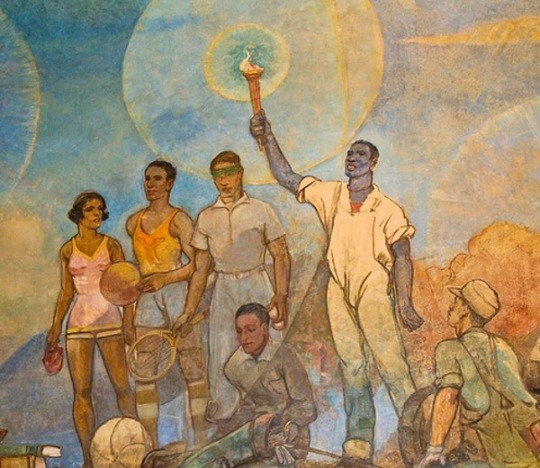
Maybe Booker proposes to Nile on the dance floor at a club where Louis Armstrong is playing.
If all you ever want to share with this fandom of your WW1 au is these tags, I will cherish them always. But if you want to share those 5 paragraphs, or write bullet point brain dump fic-outline fic, or call out sick from all your responsibilities and write 10k or 50k or however long fic that will almost certainly become one of the defining pieces of Nile Freeman fandom, ENCOURAGEMENT I ENCOURAGE YOU IF YOU WANT TO DO IT OH MY GOD DO IT
#nile freeman#book of nile#the old guard#sebastien le livre#jewish booker#slavery cw#lynching cw#kkk cw#antisemitism#chicago#book of nile ww1 au#punch that klansman#ficlet recs#fic ideas#fandom friends#i'm so overwhelmed
37 notes
·
View notes
Text
Greek Literature
Henlo there demons, its ya boi, Nyah Lajom.
I'll be talking about Greek literature in this blog and its dominant themes throughout history.
PRE-CLASSICAL PERIOD (800 BC - 500 BC)
The Greeks produced poetry in this period, and the oral tradition handed down myths and legends. Tragedies and comedies appeared, and Greek Literature began.
At the beginning of Greek Literature, we must recall 2 famous authors. The Iliad and Odyssey, both of which are sources of Greek mythology, were written by Homer.
The Iliad tells of the battles and events during the weeks of the quarrel between King Agamemnon and the warrior Achilles, set during the Trojan War, the 10-year siege of the city of Troy by a coalition of Mycenaean Greek.
(ᴛʀᴏʏ ꜱᴛᴏʀʏ 1)

The Odyssey, the poem is divided, as with the Iliad, into 24 volumes. It follows the Greek hero Odysseus, King of Ithaca, and, after the Trojan War, his journey home.
(ᴛʀᴏʏ ꜱᴛᴏʀʏ 2)

Hesiod wrote the Theogony and its all about the Greek Gods and their genealogy. All of these (The Iliad, Odyssey and Theogony) are our main sources about Greek Pantheon.
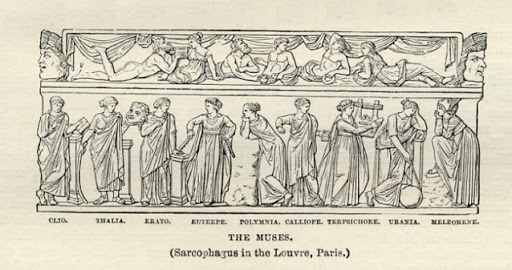
CLASSICAL PERIOD (500 BC - 323 BC)
Philosophical and theatrical literature emerged during this time. A canonical community of ancient Greek poets revered by the scholars of Hellenistic Alexandria as worthy of critical study were the Nine Lyric Poets.
They were:
Alcman of Sparta (choral lyric, 7th century BC)
Sappho of Lesbos (monodic lyric, c. 600 BC)
Alcaeus of Mytilene (monodic lyric, c. 600 BC)
Anacreon of Teos (monodic lyric, 6th century BC)
Stesichorus of Metauros (choral lyric, 7th century BC)
Ibycus of Rhegium (choral lyric, 6th century BC)
Simonides of Ceos (choral lyric, 6th century BC)
Bacchylides of Ceos (choral lyric, 5th century BC)
Pindar of Thebes (choral lyric, 5th century BC)
In this blog, I will be focusing on Sappho’s work. She is a queer woman and her work provided a rare glimpse into the lives of queer women in ancient Greece.

(Sappho 31)
Playwrights were developed and Philosophical Literature began. The meaning of life was challenged by Plato, Aristotle and Socrates and they wondered about the environment.
They created theories that piqued the interest of people and also helped us because future philosophers and scientists either tried to prove their theories or suggest a new one. It is a never-ending loop of investigation and tests that have contributed to the inventions and expertise of today.
The comedy arose from a ritual in honor of Dionysus. These plays were full of obscenity, abuse, and insult. The surviving plays by Aristophanes are a treasure trove of comic presentation.
For an annual five- or six-day spring festival of dramatic rivalry, Aeschylus, Sophocles, Euripides, and Aristophanes wrote their plays in verse called the Great (or City) Dionysia and dedicated to Dionysus.
In honor of the god Dionysus, Dionysia was a large festival in ancient Athens, the central activities of which were the theatrical performances of dramatic tragedies and comedies from 487 BC. After Panathenaia, it was the second-most important festival.

HELLENISTIC PERIOD (323 BC - 31 BC)
Greek poetry flourished in this era, and pastoral poetry was at its height. The style of poetry mastered by Virgil, the one who wrote The Aeneid, is pastoral poetry.
The New Comedy, in which Menander was the principal exponent, portrayed the drama.
The most precious contribution of the Hellenistic period is said to be the translation into Greek of the Septuagint.

ROMAN PERIOD (31 BC - 284 AD)
In the Roman period, literature in Greek contributed important works to the subjects of poetry, satire, history, and tragedy. Histories were a big proportion of literature from this time.
Eratosthenes of Alexandria wrote on astronomy and geography
In numerous scientific disciplines, including anatomy, physiology, pathology, pharmacology, and neurology, Physician Galen pioneered inventions.
The time in which most of the novels from Ancient Greece were written.
A lot of scripture were written in this era. Including The New Testament, the Gospels and the Epistles of Saint Paul
BYZANTINE PERIOD (290 AD - 1453)
On the shared basis of the Roman political system, Byzantine literature merged Greek and Christian culture. This form of literature was set in the Near East's intellectual and ethnographic atmosphere.
Byzantine Literature was basically a cultural remix of Greek, Christian, Roman and Oriental.
Chronicle and encyclopedias arose in this period.
A chronicle is, as in a time line, a historical record of events structured in chronological order.
An encyclopedia is a reference work or compendium that offers summaries of information from all branches or from a specific area or field.

MODERN GREEK PERIOD (1453 AD - Present)
In this era Modern Greek language is used in literature and it became the norm.
The Diafotismos, a movement that translated the ideas of the European Enlightenment into the Greek world, is greatly influenced by modern Greek literature. Two famous figures from this campaign are Adamantios Korais and Rigas Feraios.
In short, Diafotismos is the Greek version of Renaissance and it greatly influenced modern Greek literature.
Nyah Lajom
4 notes
·
View notes
Text
Our Collective 18th Century Library
This is a selection of books about the 18th century fashion, history, beauty, and life. Most of them in my personal library or have consulted but have not bought (yet). This post is going to be edited with more books added and reblogged for all to see, that’s why I called this post “our collective 18th century library”, from me to you all and then for you all to all of us.
Please add other books you have in your collections or you’ve read! And if you could keep the format (cover photo, book info, a little comment, the themes we can find in the book, and the link of where to find them), it will be consistently useful for everyone!
Let’s start:
ART

Casta Painting: Images of Race in Eighteenth-Century Mexico, by Ilona Katzew, Yale University Press, 2005, ISBN-10: 0300109717
Casta painting is a whole genre created in Mexico for depicting the population of the New Spain, and it’s whole purpose was to show the Spanish King what an organised viceroyalty it was, and how everyone has their proper place, even if that was not entirely true.
Themes: fashion (for visual reference), castas, race, Mexico, New Spain, Viceroyalty, the Americas, Mexico City, art, 18th century.
Available at: Amazon / Barnes and Noble / Waterstones

Painted in Mexico, 1700-1790: Pinxit Mexici, edited by Ilona Katzew, Prestel Publishing, 2017, ISBN: 978-3-7913-5677-8
The book from the exhibition about art made in Mexico City during the 18th century.
Themes: art, portraits, casta painting, Mexico, Mexico City, Viceroyalty, New Spain, the Americas, castas, religion, catholicism, 18th century.
Available at: Amazon / Amazon (Spanish version) / Target / Waterstones
HISTORY
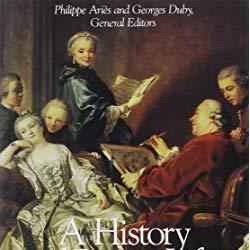
A History of Private Life, Volume III: Passions of the Renaissance, Edited by Roger Chartier, Series edited by Phillippe Ariès, Harvard University Press, 1993, ISBN 9780674400023
The life or ordinary people from the Renaissance to the Enlightenment, centered in Europe and especially France, you’ll read about the everyday lives of women and children, common men, education, marriage and well, the private life. This whole series (of 5 volumes) is worth each penny.
Themes: everyday life, history, women, Europe, France, children, education, Renaissance, Enlightenment, 16th century, 17th century, 18th century.
Available at: Amazon / Harvard University Press

A History of Private Life, Volume IV: From the Fires of Revolution to the Great War, Edited by Michelle Perrot, Series edited by Phillippe Ariès, Harvard University Press, 1993, ISBN 9780674400030
The first part is 18th century and deals with life pre, during and after French Revolution.
Themes: everyday life, history, women, Europe, France, children, education, Enlightenment, French Revolution, Victorian, Belle Epoque, WWI, 18th century, 19th century, 20th century.
Available at: Amazon / Harvard University Press

Black London: Life Before Emancipation, by Gretchen Gerzina, Rutgers University Press, 1995, ISBN-10: 0813522722
A glimpse into the lives of the thousands of Africans living in eighteenth century London.
Themes: everyday life, history, race, black, African, England, London, slavery, 18th century.
Available at: Amazon / You can also download it for FREE (ha! who needs Amazon now?)

Historia De La Vida Cotidiana En México 3: El siglo XVIII: entre la tradición y el cambio, by Pilar Gonzalbo Aizpuru, Fondo de Cultura Económica, 2012. ISBN-10: 9681677188
Common life in Mexico during the 18th century, from fashion, food and the markets, to the everyday life of mining cities, children and monks. This is book is a key reference for starting to read about the life of common people in the New Spain. Part of a series from the prehispanic times to the 20th century.
Themes: fashion, food, everyday life, New Spain, Mexico, Viceroyalty, The Americas, castas, mining, religion, catholicism, education, childhood, 18th century.
Available at: Amazon / Cambridge University Press / Fondo de Cultura Económica
FASHION

Auguste Racinet. The Costume History (Bibliotheca Universalis), Françoise Tétart-Vittu, Taschen, 2019, ISBN-10: 3836555409
I wanted to describe my undying love for this book, but I’m just gonna copy Taschen’s description: “Racinet’s Costume History is a landmark in the study of clothing and fashion. This reprint presents Racinet’s exquisitely precise color illustrations, as well as his delightful descriptions and witty commentary. From Eskimo attire to high French couture, this is an unrivalled encyclopedia for students, designers, artists, illustrators, and historians, and anyone interested in style.” So, yeah, this 19th century book rules.
Themes: fashion, interior design, furniture, 18th century, 19th century, fashion history, ancient times, middle ages, renaissance, baroque, rococo, victorian, menswear, womenswear.
Available at: Amazon / Taschen

Costume in Detail: 1730-1930, Nancy Bradfield, Quite Specific Media Group Ltd, 1999, ISBN-10: 0896762173
Focused on womenswear, Nancy Bradfield shares with all of us detailed illustrations and descriptions, as well as good information about fashion, garments, shapes, finishings, etc, of extant garments in private collections. A wonderful reference book for reproducing fashion and for illustrations or authors who want to give their character accurate fashion.
Themes: fashion,womenswear, extant garments, 18th century, 19th century, 20th century.
Available at: Amazon / Book Depository
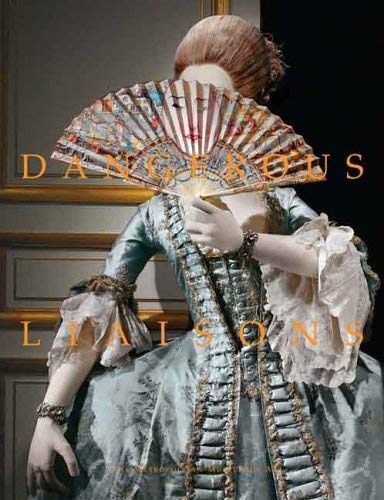
Dangerous Liaisons: Fashion and Furniture in the Eighteenth Century, by Harold Koda, Andrew Bolton, Mimi Hellman, Metropolitan Museum of Art 2006, ISBN-10: 0300107145
The book from a long gone exhibition at the Met Museum, it has extant clothes, good info, and the links between fashion and furniture design that make us perceive both as purely 18th century.
Themes: fashion, interior design, furniture, museum collections, extant garments, exhibition, 18th century.
Available at: Amazon / Metropolitan Museum of Art
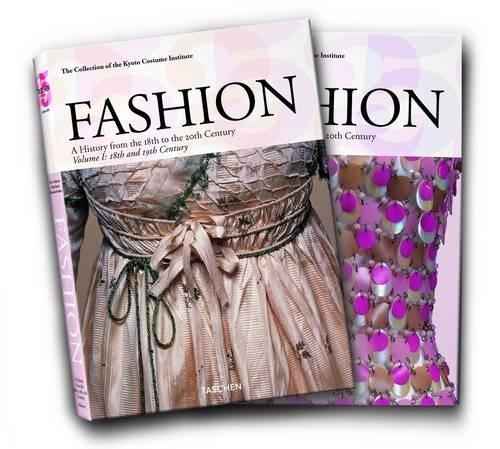
Fashion, A history from the 18th to the 20th century, by Akiko Fukai, Taschen 25th anniversary edition, 2007.
A basic fashion history book starting in the 18th century from the amazing collection of the Kyoto Costume Institute.
Themes: fashion, womenswear, menswear, embroidery, accessories, museum collection, extant garments, England, France, Europe, undergarments, 18th century, 19th century, 20th century.
Available at: Amazon in 1 volume and 2 volumes set.

Gallery of Late-Seventeenth-Century Costume: 100 Engravings, Caspar Luyken, Dover Publications, 2003, ISBN-10: 0486429865
Reprint of a collection of plates by Dutch engraver Caspar Luyken published in 1694. It shows men and women of different social classes and occupations. A key reference when looking for 17th century contemporary source material.
Themes: fashion, menswear, womenswear, Dutch, engraving, plates, 17th century, baroque, late 17th century, contemporary source.
Available at: Amazon / Dover Books

Historic Costumes and How to Make Them (Dover Fashion and Costumes), by Mary Fernald and Eileen Shenton, Dover Publications, 2006, ISBN-10: 0486449068
From the Middle Ages to the 19th century fashion, this book is a nice resource for theatrical costuming and has good but basic bits of historical fashion information. I recommend not to buy with no previous patternmaking and fashion background, since the diagrams are quite vague, and the descriptions even more. I personally only have used this book for reference of Medieval and early Renaissance fashion (which to be fair, are quite simple). Also, it is centered in English fashions.
Themes: fashion, theatre, menswear, womenswear, middle ages, renaissance, tudors, elizabethan, georgian, victorian, 15th century, 16th century, 17th century, 18th century, 19th century.
Available at: Amazon / Barnes and Noble / Dover Publications / Waterstones

How to Read a Dress, A Guide to Changing Fashion from the 16th to the 20th Century, Lydia Edwards, Bloomsbury Academic, 2017, ISBN-10: 1472533275
This books is very pretty and rather basic, it could be a really nice starting point for anyone getting an interest in fashion history. I’ve read reviews that it is “insultingly basic” which I do not get, I mean, if you cannot explain something in such a basic way that a child can get it, then you do not really master that subject. This books has pretty interesting info and it is a walkthrough of key silhouettes and extant garments, so it is not deeply detailed nor shows each and every silhouette of every decade of every century.
Themes: fashion, womenswear, gown, dresses, extant garments, museums, Europe, 16th century, 17th century, 18th century, 19th century, 20th century.
Available at: Amazon / Bloomsbury

Men's Garments 1830-1900: A Guide to Pattern Cutting and Tailoring, R. I. Davis and William-Alan Landes, Players Press, 1996, ISBN-10: 0887346480
A whole book only for menswear starting with the Regency silhouette and its very particular form until the turn of the 20th century. Yes. It is pretty good, I have to say, for all our Victorian outfit needs for the gentleman. I recommend this book (and the 2nd one on 19th and 20th centuries) for people with some knowledge of construction, grading, fitting, patternmaking, and tailoring, since it does not offer much sewing advice.
Themes: fashion, menswear, accessories, patternmaking, plates, 19th century, 20th century.
Available at: Amazon / Waterstones
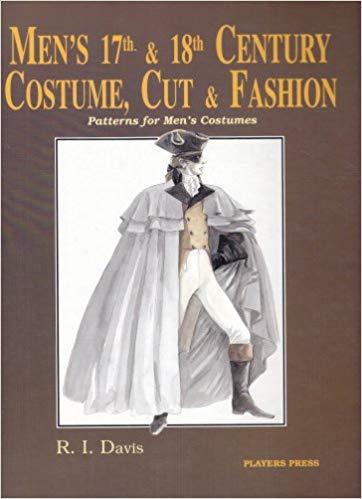
Men's Seventeenth & Eighteenth Century Costume: Cut and Fashion, R. I. Davis and William-Alan Landes, Players Press, 2000, ISBN-10: 0887346375
My personal love for menswear is fueled by this book that details the suits, coats and tailcoats from the 17th and 18th centuries. It includes military fashion and other everyday clothes like breeches, capes, waistcoats, etc. via plates, figures, diagrams and texts. I recommend this book (and the 1st one on 19th and 20th centuries) for people with some knowledge of construction, grading, fitting, patternmaking, and tailoring, since it does not offer much sewing advice.
Themes: fashion, menswear, accessories, patternmaking, plates, 17th century, 18th century.
Available at: Amazon / Book Depository
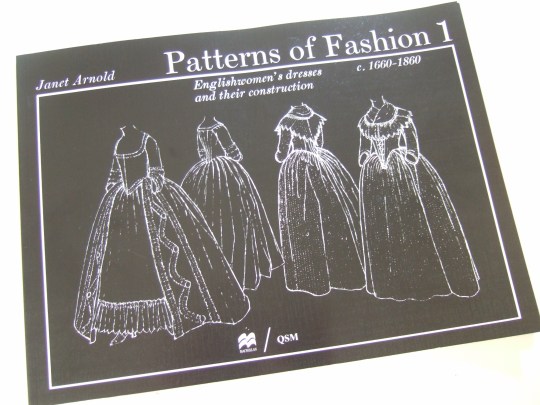
Patterns of Fashion 1: Englishwomen's Dresses and Their Construction C. 1660-1860, by Janet Arnold, Drama Publishers, 2005, ISBN-10: 9780896760264
THE key source of patterns of extant garments, this series of books are the result of constant research on garments from museums, with details and info on construction, history and fashion details. You know, the kind of information you could only get with those garments in your hands.
So, as a resume, in this list there’s only the books with 18th century info in them, BUT you should actually have ALL of the Patterns of Fashion books.
Themes: fashion, womenswear, England, extant garments, museums, Europe, patternmaking, 17th century, 18th century, 19th century.
Available at: Amazon
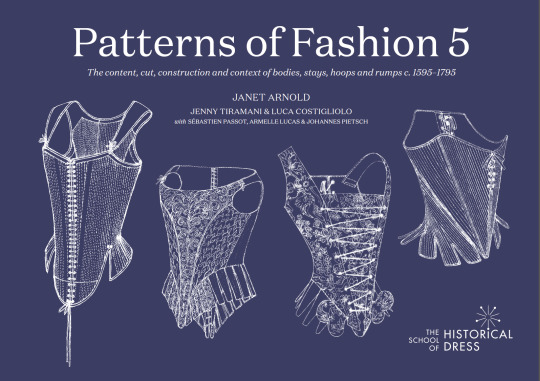
Patterns of Fashion 5: the content, cut, construction & contexto of bodies, stays, hoops & rumps, c 1595-1795, by Janet Arnold, Jenny Tiramani, Luca Costigliolo, Sebastien Passot, Armelle Lucas and Johannes Pietsch, The School of Historical Dress, 2019
The new book from the series is about undergarments from the 16th to the 18th century. It is only available through the store of the School of Historical Dress. Probably the best spent £35.
Themes: fashion, undergarments, stays, womenswear, England, extant garments, museums, Europe, patternmaking, 16th century, 17th century, 18th century.
Available at: The School of Historical Dress

Pictorial Encyclopedia of Historic Costume: 1200 Full-Color Figures, Karl Rohrbach (Author), Albert Kretschmer (Compiler), Dover Fashion and Costumes, 2007, ISBN-10: 0486461424
A reprint of Die Trachten Der Völker from 1906, this book, this is a great great encyclopedic work of fashion history, from ancient Egypt to late 19th century. It includes clothes for people of different social backgrounds, accessories, jewels, shoes, etc. I think that for the fashion history lover, the Rohrbach+Racinet combo is a must.
Themes: fashion, interior design, furniture, 18th century, 19th century, fashion history, ancient times, middle ages, renaissance, baroque, rococo, victorian, menswear, womenswear.
Available at: Amazon / Dover Publications
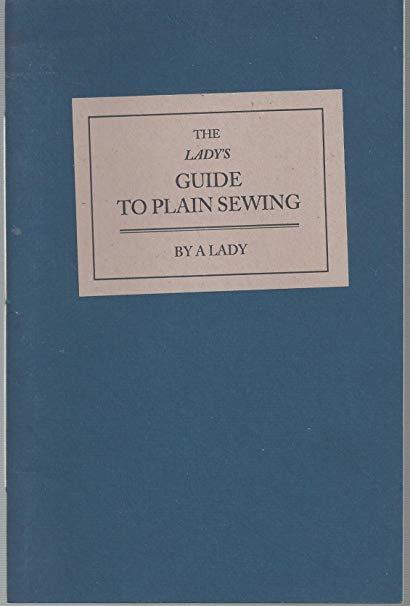
The Lady's Guide to Plain Sewing, Book I, Kathleen Kannik, ISBN 10: 0-9640161-0-9
References and tips for plain hand sewing, a key reference to achieve basic stitches that are historically accurate. It includes basic construction of items and some decorative techniques. Many of these techniques are still used in couture. This book is part 1 of a set of 4.
Themes: fashion, undergarments, womenswear, menswear, sewing, stitches, techniques, how to, patternmaking, 17th century, 18th century, 19th century, 20th century, couture.
Available at: Kannik’s Korner / Amazon (kindle edition) / Amazon

The Lady's Guide to Plain Sewing, Book II, Kathleen Kannik, ISBN 0-9640161-2-5
More sewing stuff with additional stitches and seam techniques, gather attachments, button making, gussets, re-enforcements, cord making, and an 18th century alphabet for cross stitching. This book is part 2 of a set of 4.
Themes: fashion, undergarments, womenswear, menswear, sewing, stitches, techniques, how to, patternmaking, 17th century, 18th century, 19th century, couture.
Available at: Kannik’s Korner / Amazon
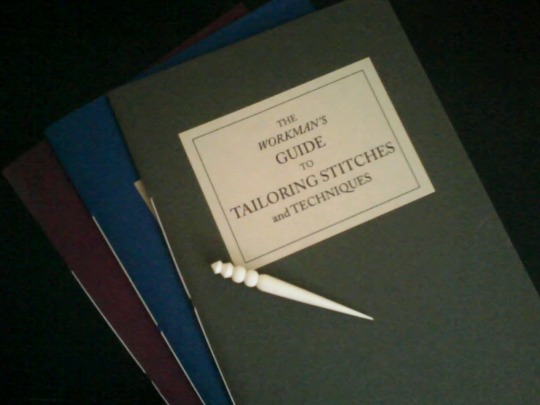
The Workman's Guide to Tailoring Stitches and Techniques, Kathleen Kannik, ISBN 0-9640161-4-1
Now it’s time for historical tailoring stitches and techniques. This book is part 3 of a set of 4.
Themes: fashion, tailoring, menswear, sewing, stitches, techniques, how to, patternmaking, 17th century, 18th century, 19th century.
Available at: Kannik’s Korner / Amazon

The Lady's Economical Assistant or, The Art of Cutting Out, and Making, The most useful Articles of Wearing Apparel, Without waste; Explained by the Clearest directions, and Numerous Engravings, of Appropriate and Tasteful Patterns, ISBN 0-9640161-3-3
A re-drawn publication of a 1808 book, with cutting directions and patterns for infant clothes, girls, boys, some for men and women, and linens. Many illustrations and a supplement. This book is part 4 of a set of 4.
Themes: fashion, undergarments, kidswear, children, babies, infants, womenswear, menswear, sewing, stitches, techniques, how to, patternmaking, 17th century, 18th century, 19th century.
Available at: Kannik’s Korner / Amazon

The American Duchess Guide to 18th Century Dressmaking: How to Hand Sew Georgian Gowns and Wear Them With Style, by Lauren Stowell and Abby Cox, Page Street Publishing, 2017, ISBN-10: 1624144535
This book is such a good starting point for a 18th century wardrobe, since it walks you through the key outfits of the century in a simple and clear way. I think a background in patternmaking is a plus, especially for the most complex projects, but the basics are easy to follow.
Themes: fashion, patternmaking, how to, womenswear, 18th century.
Available at: Amazon / American Duchess
BEAUTY

18th Century Hair & Wig Styling: History & Step-by-Step Techniques, Kendra Van Cleave, Nice One, ISBN-10: 0692220437
Kendra van Cleave have been everyone’s guide into the 18th century beauty and hair (and of course, costuming) for quite a long time, thanks to her blog, Démodé, and now she published this well researched book with easy to follow instructions for all kinds of 18th century hairstyles. So, go get your wig and get to work. Also, at the book’s website there some videos, and at her blog you can find even more resources, tutorials, etc.
Themes: fashion, beauty, hair, wigs, 18th century, how to.
Available at: Amazon / 18th Century Hair Website

The American Duchess Guide to 18th Century Beauty: 40 Projects for Period-Accurate Hairstyles, Makeup and Accessories, by Lauren Stowell and Abby Cox, Page Street Publishing, 2019, ISBN-10: 1624147860
I KNOW this is not available yet, but I think it will be at least as good as the fashion one. Already on my pre-order list, it will be available on July 9th.
Themes: hair, hairstyles, hair and makeup, makeup, accessories, how to, womenswear, 18th century.
Available at: Amazon / American Duchess
#sometimes I write stuff#books#my 18th century library#or something#18th century#fashion#history#beauty
624 notes
·
View notes
Text
Sophie Tucker and Gladys Bentley

Sophie Tucker and Gladys Bentley
Against her family's wishes, Sophie Tucker (1884-1966) went into vaudeville and became an international star. She sang Blues and Jazz but is best known for her comedy songs often with risqué lyrics earning her the nickname the “Last of the Red Hot Mamas”.
Because she was considered too big and too ugly to perform as a white woman, she had to start out in blackface even though she hated it. While performing in Boston, the costume trunks were lost and she was finally able to go on stage without blackface. She shocked the audience by declaring “You-all can see I’m a white girl. Well, I’ll tell you something more: I’m not Southern. I’m a Jewish girl and I just learned this Southern accent doing a blackface act for two years. And now, Mr. Leader, please play my song.” The audience adored her wit, charm, talent, and body-positive attitude. She never had to wear blackface again.
Her two most famous songs are her signature song, “Some of These Days” (written in 1910 by Black composer Shelton Brooks) and “My Yiddishe Momme” which honored her Jewish heritage and is still sung in both Yiddish and English. In 1932, Sophie was met with antisemitism at a concert in France when she sang it, and in Germany, her records were smashed.
Tucker was deeply committed to helping others. She contributed to the Jewish Theatrical Guild, the Catholic Actors Guild, the Negro Actors Guild, and formed the Sophie Tucker Foundation. She donated to synagogues and hospitals. While on the road, she would help prostitutes by giving them money to stash away from their pimps. She and her band even did a performance at a house of prostitution who had taken the night off in her honor. She saw the women as people just trying to do their best in a difficult world and never judged them.
Sophie Tucker was one of the most popular and beloved performers of the 20th Century. She was a dear friend of Dr. Margaret “Mom” Chung (WCW 68). Comedian and actor Bette Midler’s character, “Soph”, is a direct reference to Sophie Tucker.
Gladys Bentley (1907-1960) was another beloved performer of the 20th Century. She sometimes used the stage name Bobbie Minton. Similar to Sophie Tucker, she did not fit the standard beauty norms. Outspoken, large, lesbian, and Black, she wore a trademark white tuxedo on stage.She was a fierce piano player and powerful singer who pushed the limits with racy lyrics and bawdy manner.
Even as a child, she felt more comfortable dressing in men’s clothing. Despite struggling financially, her parents took her to many doctors to cure her. At sixteen she ran away to New York to become a performer. Boldly flaunting her bulldagger (butch) style, she became a super star of the Harlem Renaissance and performed at all the best clubs such as the Clam House, the Cotton Club, and the Apollo. Bentley headlined at the Ubangi Club with drag queens as her chorus. As a Black lesbian woman in the 1920s, she owned a Park Avenue apartment with servants and famously “married” a white woman.
Times became tough for her during the depression. Most nightclub work dried up. She moved to Los Angeles and was often harassed for wearing men’s clothing but was able to keep working enough to survive by performing at the underground gay clubs there.
Sadly, the social climate of the 50s was too much for her to bear. She had to deny who she was. In 1952, she published an essay called “I Am A Woman Again” in “Ebony” magazine. She publicly declared that she had been “cured” of lesbianism and was happily married to a man. She later divorced him and was preparing to become an ordained minister for The Temple of Love in Christ, Inc., but she died of the flu before she could achieve that goal. She was 52 years old.
Bonus Links:
Sophie Tucker singing “My Yiddishe Momma”
https://youtu.be/triCX77tl8s
Discography for Sophie Tucker
https://adp.library.ucsb.edu/index.php/mastertalent/detail/105584/Tucker_Sophie
Gladys Bentley appeared twice on Grocho Marx’s “You Bet Your Life” This is the only record of her television appearance.
https://www.youtube.com/watch?v=j-LTJNasTMc
Discography of Gladys Bentley (Most of her repertoire was not recorded.)
https://adp.library.ucsb.edu/index.php/mastertalent/detail/107258/Bentley_Gladys
Sources:
https://jwa.org/encyclopedia/article/tucker-sophie
https://legacyprojectchicago.org/person/gladys-bentley
https://www.blackpast.org/african-american-history/bentley-gladys-1907-1960/
#suffragettecity100#sophie tucker#yiddish#yiddisha momma#jazz#blues singer#women in showbusiness#vaudeville#red hot mama#some of these days#jewish girl#gladys Bentley#bobbie minton#lesbian#black lesbian#black woman#black history#harlem renaissance#clam house#ubangi club#drag queen#bulldagger#transgender#LGBTQ#gender bender#blackface#jazz singer#african american history#blacklivesmatter#women's history
4 notes
·
View notes
Text
Writing Research - Alchemy
Alchemy (from Arabic: al-kīmiyā) was an ancient branch of natural philosophy, a philosophical and protoscientific tradition practiced throughout Europe, Africa, and Asia, originating in Greco-Roman Egypt in the first few centuries AD.
Alchemists attempted to purify, mature, and perfect certain materials. Common aims were chrysopoeia, the transmutation of "base metals" (e.g., lead) into "noble metals" (particularly gold); the creation of an elixir of immortality; the creation of panaceas able to cure any disease; and the development of an alkahest, a universal solvent. The perfection of the human body and soul was thought to permit or result from the alchemical magnum opus and, in the Hellenistic and Western mystery tradition, the achievement of gnosis. In Europe, the creation of a philosopher's stone was variously connected with all of these projects. [x]
Alchemy is generally seen as an archaic proto-science based on superstition that is of little interest to the modern chemist. In truth, chemistry owes much to alchemy because many of the discoveries and chemical knowledge we have today is because of it (such as the chemistry-related processes of the working of metals and alloys, glassmaking and glass coloring, and the preparation and use of pigments, dyes, and therapeutic agents).
Live Science - What is Alchemy?
Britannica - Alchemy
Encyclopedia - Alchemy
Royal Society of Chemistry - What is Alchemy?
MINING - What is alchemy and is it even real?
University of Bristol School of Chemistry - A Brief History of Alchemy
AlchemyLab - Origins of Alchemy
Science Museum - Alchemy
Encyclopedia - Alchemy: Renaissance Alchemy
American Institute of Physics: Inside Science - Alchemy Renaissance
ThoughtCo. - Alchemy in the Middle Ages
The Scientist Magazine - Medicinal Alchemy, circa 1512
Khan Academy - From Alchemy to Chemistry
The Getty - Your Questions About Alchemy—From Its Origins to The Philosopher’s Stone—Answered
The New York Times - Readers’ Questions Answered--Ask Science: Alchemy
The New York Times - Transforming the Alchemists
Wikipedia - Alchemical Tools
The Robinson Library - The Alchemist's Equipment
Reddit: AskHistorians - Where did an alchemist get their metals?
Reddit: AskHistorians - What did early chemists/alchemists use for heat sources?
Ancient Origins - Speculum Alchemiae: Secret Underground Alchemy Lab Discovered in Prague During Flood
The Washington Post - This man is not a wizard -- but he knows all about alchemy: Inside the lab of an alchemy expert
AlchemyLab - Alchemy Electronic Dictionary
ThoughtCo. - Alchemy Symbols and Meanings
Brown University - Alchemical Symbols As Secret Code
Science Notes - Alchemy Symbols and Their Meanings
Wikipedia - List of alchemical substances
Britannica - Philosopher’s stone
HISTORY - What was the philosopher’s stone?
MEL Science - What is the philosopher’s stone?
Wikipedia - Philosopher's stone
ThoughtCo. - The Three Primes of Alchemy
Wikipedia - List of Alchemists
Reddit: AskHistorians - Did women participate in alchemy in medieval times? If so, how were these women viewed by society? Was there a gender bias in favor of men, as there was in the infancy of science?
University of Bristol School of Chemistry - Famous Alchemists
PBS - Newton the Alchemist
Discover Magazine - Isaac Newton, World’s Most Famous Alchemist
Listverse - 10 Alchemists Who Created Strange Modern Legacies
ThoughtCo. - Ancient Chinese Invented Gunpowder: A History
Real Archaeology - The Creation and Adoption of Gunpowder
Live Science - How Gunpowder Changed the World
Science History Institute - The Secrets of Alchemy
Chemical & Engineering News (C&EN) - Science Historians Revive Ancient Recipes
Scientific American - Fact or Fiction?: Lead Can Be Turned into Gold
ThoughtCo. - Turn Water Into Liquid Gold With an Alchemy Experiment
Scientific American - DIY Alchemy: How to “Transmute” Copper into Brass
MEL Science - “Alchemist’s gold” Experiment
Youtube - Testing A Possible Origin To Alchemy: The Golden Rain Experiment [Video]
ACS Publication: Journal of Chemical Education - Experiments in Alchemy. Part I: Ancient Arts [PDF]
ACS Publication: Journal of Chemical Education - Experiments in Alchemy. Part II: Medieval discoveries and “transmutations” [PDF]
Youtube - TheBackyardScientist: How to Grow A Lead Crystal Tree! Old Alchemy Demonstration [Video]
University of Warwick - Reproducing Alchemical Experiments
National Public Radio - Phosphorus Starts With Pee In This Tale Of Scientific Serendipity
Youtube - The Alchemist Who Discovered Phosphorus in Pee [Video]
The Vintage News - German alchemist Hennig Brand discovered phosphorus when he tried to make gold from urine
Stanford University - Artificial Men: Alchemy, Transubstantiation, and the Homunculus
HowStuffWorks: Stuff to Blow Your Mind - How to Make a Homunculus and Other Horrors
Ancient Origins - Homunculus: The Alchemical Creation of Little People with Great Powers
Youtube - Home Alchemy: Man creates Monster in his basement with Sperm and Chicken Egg [Video]
Forbes - The Day England Outlawed Alchemy
Internet Sacred Text Archive - The Theory and Practice of Alchemy: Part One
Atlas Obscura - How to Turn Plants Into Tinctures, Like an Ancient Alchemist
Ancient Origins - Spagyric Secrets of The Alchemists: Alchemy as Alternative Medicine
Hermetic Library - Practical Plant Alchemy: Part One
Youtube - SoF/Heyman Center: Testing the Panacea: Antidotes, Alchemy, and the Problem of Proof in Early Modern Europe [Video]
University of Cambridge - All is not what it seems: The blurred boundaries between alchemy and medicine
The Boston Globe - What alchemists got right about chemistry
Indiana University: Research and Creative Activity - Sir Isaac's Alchemy
National Geographic - Isaac Newton’s Lost Alchemy Recipe Rediscovered
The Washington Post - This chemist is unlocking the secrets of alchemy
Youtube - Bytesize Science: Inside the Mind of an Alchemist featuring Larry Principe [Video]
Ultraculture - How Alchemy, the Forbidden Science, Changed World History
Phys.org - Why many historians no longer see alchemy as an occult practice
Smithsonian Magazine - Alchemy May Not Have Been the Pseudoscience We All Thought It Was
Numericana - From Alchemical Recipes to Modern Chemistry
History of Alchemy | A podcast by Travis J. Dow [Audio]
Science History Institute - Books of Secrets: Writing and Reading Alchemy
Science of History Institute - The Secrets of Alchemy
AlchemyLab - Original Alchemy Texts: Suggested Books
Internet Archive - Collection des Anciens Alchimistes Grecs [Collection of Ancient Greek Alchemists] by Berthelot, M. (Marcellin), 1827-1907 & Ruelle, Ch.-Em., 1833-1912
Google Translate - Collection des Anciens Alchimistes Grecs
Amazon: Books - The Book Of Alchemy: The Pursuit Of Wisdom And The Search For The Philosopher's Stone by Francis Melville
Google Books - The Alchemist's Kitchen: Extraordinary Potions & Curious Notions by Guy Ogilvy
Amazon: Books - Real Alchemy: A Primer of Practical Alchemy by Robert Allen Bartlett
Google Books - Alchemists Handbook: Manual for Practical Laboratory Alchemy by Frater Albertus
AlchemyLab - Resources for Alchemists
Note: This post does NOT focus on fictional alchemy.
#Alchemy#Alchemist#writing#writing research#writing reference#writing resources#writing help#writing advice#writing references#writing fanfiction#fanfiction help#research#real alchemy#real life alchemy
98 notes
·
View notes
Text
The Women Behind the Pre-Raphaelite Brotherhood
https://sciencespies.com/history/the-women-behind-the-pre-raphaelite-brotherhood/
The Women Behind the Pre-Raphaelite Brotherhood
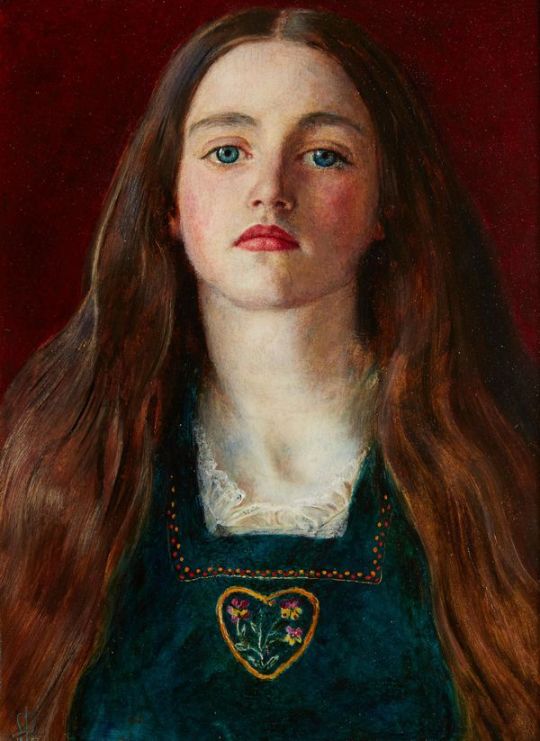
SMITHSONIANMAG.COM |
Jan. 22, 2020, 4:56 p.m.
The women of the Pre-Raphaelite sisterhood have gone down in history as muses. Despite being artists in their own right, they are remembered as symbols, rather than creators, of beauty. Now, an ongoing exhibition at the National Portrait Gallery in London gives these long-overlooked figures a space of their own, sharing their stories through works of art, poems and embroidery.
On view through January 26, “Pre-Raphaelite Sisters” centers on 12 women—among others, the roster includes Christina Rossetti, Effie Millais and Elizabeth Siddal—and their contributions to the male-dominated narrative of the Pre-Raphaelite Brotherhood, a circle of artists active between 1850 and 1900. The show draws on unseen works from both public and private collections around the world to reshape perceptions of these individuals as creative artists and poets who advocated for their own stories to be told rather than simply objectified muses.
“Visitors see these women’s own art, and their roles as collaborators and business partners, not just as lovers and wives,” writes the Atlantic’s Helen Lewis. “The captions restore names to the faces gazing placidly from postcards and posters.”

John Everett Millais, Sophy Gray, 1856
(Courtesy of National Gallery / Private collections)
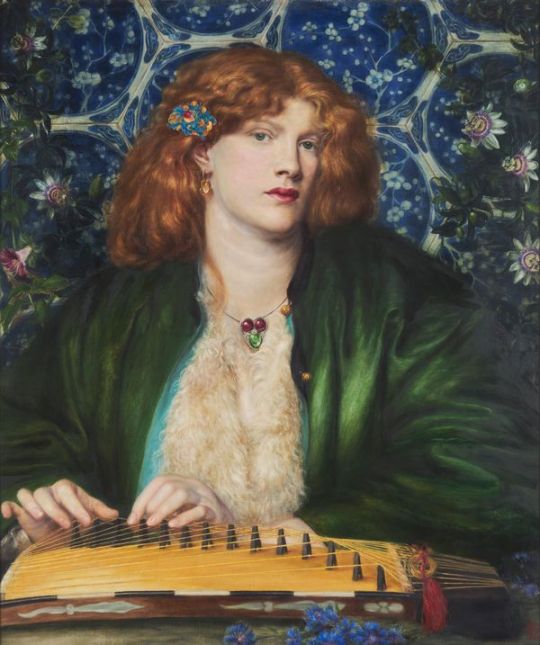
Dante Gabriel Rossetti,The Blue Bower, 1865
(The Henry Barber Trust, the Barber Institute of Fine Arts, University of Birmingham)
In 1848, then-students Dante Gabriel Rossetti, William Holman Hunt and John Everett Millais founded the Pre-Raphaelite Brotherhood in opposition to the more traditional art espoused by the Royal Academy. The original founders, all of whom were under the age of 25, soon invited four other male painters, sculptors and critics to join their secret society. Members heavily rejected the Academy’s promotion of Renaissance master Raphael, as well as the genre painting popular at the time.
Per Encyclopedia Britannica, the Brotherhood’s work focused on religious and medieval themes. Painted with maximum realism inspired by 15th-century Florentine and Sienese paintings, the young artists’ naturalistic creations were populated by beautiful women. The cryptic initials “PRB” appeared in the bottom corner of early Pre-Raphaelite works.
Simply put, the Brotherhood was a boys’ club that intentionally excluded women.
“Though its goals were ‘serious and heartfelt,’” explains Dinah Roe, a senior lecturer at Oxford Brookes University, for the British Library, “the PRB was founded in a spirit of waggish male camaraderie which expressed itself in pranks, late-night smoking sessions and midnight jaunts around London’s streets and pleasure gardens.”
The Brotherhood’s models, who often doubled as the artists’ lovers, were usually at the center of their creations. But some, like Siddal, used their seemingly passive roles as models to fund their own artistic careers alongside their elite husbands.
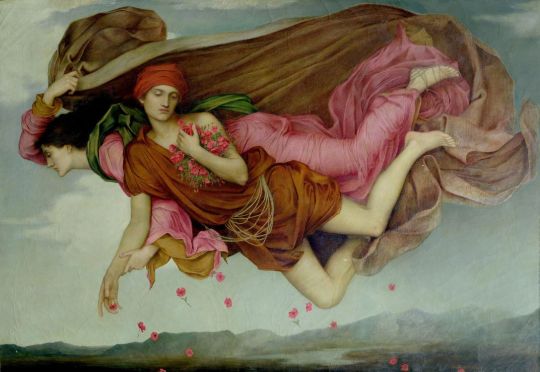
Evelyn De Morgan, Night and Sleep, 1878
(De Morgan Collection, courtesy of the De Morgan Foundation)
Siddal is among the Pre-Raphaelite women painted over by history. She started modeling not to gain the attention of men, but to fund her own artistic practice. Initially working part time at her parents’ hat shop while modeling on the side, Siddal gained an unprecedented amount of popularity in the Pre-Raphaelite circle, with her likeness becoming a symbol of feminine beauty.
Lying motionless, with her pale, delicate face encircled by a fiery halo of red hair, Siddal is the subject of one of the movement’s most famous paintings, Millais’ Ophelia. Following the success of this piece, Siddal became perhaps the face of the Pre-Raphaelite movement. She later married artist and Brotherhood member Dante Gabriel Rossetti, who drew and painted her “thousands” of times, according to the BBC’s Lucinda Hawksley.
Siddal’s own artistic journey was far more extensive than previously believed. As seen in the exhibition, she created paintings with archetypal Pre-Raphaelite qualities, including detailed medieval scenes and precise figures. She wrote haunting poetry, drawing on her experiences with drug addiction, an unfaithful husband and a stillborn daughter, but didn’t live to see them in print; the verses were only published after her death in 1862.
“Far from passive mannequins, […] these women actively helped form the Pre-Raphaelite movement as we know it,” says curator Jan Marsh in a statement. “It is time to acknowledge their agency and explore their contributions.”

Dante Gabriel Rossetti, Proserpine, 1877
(Courtesy of the National Gallery of Art / Private collections)

William Holman Hunt, Il Dolce far Niente,1866
(Private Collection, © Grant Ford Ltd)
The exhibit, described by Lewis as “revelatory,” includes more examples of the Brotherhood’s depictions of its 12 subjects than works by the women artists themselves. This dynamic offers visitors a sharp contrast—one can see the Brotherhood’s interpretation of the models next to works that envision them as more than muses.
The Pre-Raphaelite sister who perhaps best exemplifies this dichotomy is Jane Morris. With her full lips and strong features, Morris caught the attention of several Pre-Raphaelite men eager to capture her beauty through art. Yet it was a portrait drawn by another woman, Evelyn De Morgan, in 1904, that depicted a more authentic version of Morris’ feminine beauty by showing her signature raven-colored hair turning grey with age.
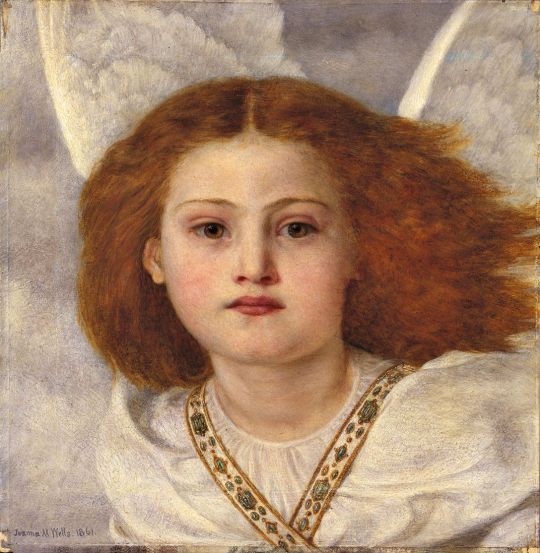
Joanna Boyce Wells, Thou Bird of God, 1861
(Courtesy of the National Gallery of Art / Private collections)
In many ways, the work completed by these women can be seen as a rare act of feminism for the time period. By shedding light on these objectified women, “Pre-Raphaelite Sisters” gives visitors the opportunity to gain a holistic view of the groundbreaking sisterhood.
“It is not sufficient to merely add some women to the Pre-Raphaelite canon,” writes Elizabeth Prettejohn in The Art of the Pre-Raphaelites. “Instead, it is a matter of writing a wholly new, and different, story about Pre-Raphaelitism—a story in which the activities of women are no longer incidental, but necessary to the plot.”
“Pre-Raphaelite Sisters” is on view at the National Gallery in London through January 26.
#History
2 notes
·
View notes